Which program are you applying to?

Accepted Admissions Blog
Everything you need to know to get Accepted

July 28, 2023

First Drafts of Residency Personal Statements: Let Yourself Go

For many residency applicants, writing the first draft of their personal statement is probably the most difficult part of the entire application process. And the most difficult part of writing that first draft is often getting the first few words on the page. Don’t fret – even accomplished novelists and famous journalists struggle to get started sometimes! Here, we’ll discuss how you can get your ideas down on the page and then transform those ideas into a compelling personal statement.
Getting started
You’ve cleared your schedule, turned off the television, and filled your coffee cup; now you’re ready to write. You fire up the computer and wait for the words to flow…
…and wait…
…and wait.
Relax, it’s not just you. Not many medical students have spent a lot of time writing essays for fun; among the rare few who have, not many have focused on writing personal statements. And there’s nothing quite like a blank page to dampen the most enthusiastic writer’s zeal. You’re probably tempted to get up and do something – anything! – rather than stare at that blank screen for another second.
We have some advice for you: DON’T.
STAY WHERE YOU ARE.
SET A TIMER FOR 15 MINUTES.
AND MOST IMPORTANT…
WRITE, WRITE, AND WRITE SOME MORE UNTIL THAT TIMER GOES OFF.
When you start to write a few words on the page – even words like “I don’t know what to say” – something miraculous happens. Suddenly, there are WORDS on the page, not just blank space. And these words will inspire you to continue writing. Words beget words, and before long, your babbling string of “I’m writing but I really don’t have anything to say” can transform into “well, maybe I have a thing or two worth mentioning” or “I saw an attending do something really smart last week.” Suddenly, you’re brainstorming!

How to make the most of your brainstorming
Every effective essay begins with brainstorming to identify what topics you want to share with program directors. Your life is full of details, and as you start writing about the important experiences in your life, you’ll start to see patterns emerge. This is true for your chosen specialty as well. If you’ve been journaling during your rotations , you probably have lots of material already. If not, then you might start by thinking about what you like most about your specialty. In addition to the technical skills required, dig into the personal qualities: the mental concentration and take-charge attitude that surgeons have, the rapport with children and parents necessary for pediatrics, the enthusiasm for puzzle-solving of internists. How do these connect to other experiences in your life? Do you see crossovers between the activities you enjoy and perform well in and the specialty you’ve chosen?
Once you’ve gotten these ideas down on paper, ask yourself these questions:
- Are there common threads running through your experiences? Do these connect with your specialty in any way?
- Do your experiences show a natural progression or maturation? Has your specialty brought out or strengthened skills you already possessed?
- Have any people or events been particularly influential? Which experiences have you been most passionate about? Which ones show your fit for this field?
Answering these questions can help you identify a theme for your essay. You’ll often find that you have more than one. And that’s okay!
Write big, even when word counts are small
When you allow your first draft to be expansive – writing and writing without worrying about limitations – wonderful things can happen. I frequently find that the best ideas are hidden, just waiting to be pulled out and put center stage. For instance, in the middle of one applicant’s multipage first draft, this gem was tucked away:
The radiology attending was pointing out how sometimes we forget that in interpretation, it is still an image and not an actual person. However, our interpretation will significantly impact the human and not the image. This same radiologist on a separate occasion, while a resident and I were looking at a plain film of the chest, brought up the same point, but in a very creative way. He pulled up a painting by René Magritte that said “This is not a pipe.” In this painting, Magritte cleverly communicates with his viewers that it was truly not a pipe, but an “image” of a pipe.
This passage concealed an essential truth of how the applicant had come to view radiology as a different way of seeing and interpreting a patient. We brought this idea to the beginning of her personal statement, using it to set the stage for an essay focused on the radiologist’s commitment to her patients:
“The Treachery of Images,” one of surrealist artist René Magritte’s most famous works, depicts an ordinary pipe with “this is not a pipe” written below it. While a resident and I examined a chest X-ray, our attending pulled out this image. I immediately understood his meaning. What we saw was not truly a pipe, only its image; similarly, this chest X-ray was only a representation of what we were really seeing. It was a reminder that what was revealed in these shadowed images – the reality behind the image – could be used to treat our patients.
Many things stand out about this introduction. This revelation about radiology is expressed in a creative way that shares something about the expanse of her education. The way she effortlessly extrapolates other aspects of her life to this chosen specialty implies a level of comfort with the specialty – a way of thinking of herself already as a practitioner. It also helped roll out a very clear structure for the essay that focused on how radiological images could help real people.
This applicant succeeded because she gave herself the freedom to write expansively in her first draft, expressing what was truly special in her story. Try giving yourself this freedom and allowing yourself to discover what is special about your own story.
Ready, set, go!
It’s still a long road from a first draft to a final essay, but getting started is often the biggest hurdle. So now, it’s time to unplug, set your alarm for 15 minutes, and write!
Need more help getting started? Ready to transform your first draft from okay to spectacular? Talk to our experts ! We’re here to answer your questions, motivate you, and help you get ACCEPTED!

Since 2001, Cydney Foote has advised hundreds of successful applicants for medical and dental education, residency and fellowship training, and other health-related degrees. Admissions consulting combines her many years of creating marketing content with five years on fellowship and research selection committees at the University of Washington School of Medicine. She’s also shared her strategy for impressing interviewers in a popular webinar and written three books and numerous articles on the admissions process. Want Cydney to help you get Accepted? Click here to get in touch!
Related Resources:
- 13 Essential Do’s and Don’ts for Your Residency Personal Statement
- 9 Secrets to Telling an Attention-Grabbing Story
- How to Get Started on Your Personal Statement with One Easy Technique
About Us Press Room Contact Us Podcast Accepted Blog Privacy Policy Website Terms of Use Disclaimer Client Terms of Service
Accepted 1171 S. Robertson Blvd. #140 Los Angeles CA 90035 +1 (310) 815-9553 © 2022 Accepted

Have a language expert improve your writing
Run a free plagiarism check in 10 minutes, generate accurate citations for free.
- Knowledge Base
- Applying to graduate school
- How to Write Your Personal Statement | Strategies & Examples
How to Write Your Personal Statement | Strategies & Examples
Published on February 12, 2019 by Shona McCombes . Revised on July 3, 2023.
A personal statement is a short essay of around 500–1,000 words, in which you tell a compelling story about who you are, what drives you, and why you’re applying.
To write a successful personal statement for a graduate school application , don’t just summarize your experience; instead, craft a focused narrative in your own voice. Aim to demonstrate three things:
- Your personality: what are your interests, values, and motivations?
- Your talents: what can you bring to the program?
- Your goals: what do you hope the program will do for you?
This article guides you through some winning strategies to build a strong, well-structured personal statement for a master’s or PhD application. You can download the full examples below.
Urban Planning Psychology History
Table of contents
Getting started with your personal statement, the introduction: start with an attention-grabbing opening, the main body: craft your narrative, the conclusion: look ahead, revising, editing, and proofreading your personal statement, frequently asked questions, other interesting articles.
Before you start writing, the first step is to understand exactly what’s expected of you. If the application gives you a question or prompt for your personal statement, the most important thing is to respond to it directly.
For example, you might be asked to focus on the development of your personal identity; challenges you have faced in your life; or your career motivations. This will shape your focus and emphasis—but you still need to find your own unique approach to answering it.
There’s no universal template for a personal statement; it’s your chance to be creative and let your own voice shine through. But there are strategies you can use to build a compelling, well-structured story.
The first paragraph of your personal statement should set the tone and lead smoothly into the story you want to tell.
Strategy 1: Open with a concrete scene
An effective way to catch the reader’s attention is to set up a scene that illustrates something about your character and interests. If you’re stuck, try thinking about:
- A personal experience that changed your perspective
- A story from your family’s history
- A memorable teacher or learning experience
- An unusual or unexpected encounter
To write an effective scene, try to go beyond straightforward description; start with an intriguing sentence that pulls the reader in, and give concrete details to create a convincing atmosphere.
Strategy 2: Open with your motivations
To emphasize your enthusiasm and commitment, you can start by explaining your interest in the subject you want to study or the career path you want to follow.
Just stating that it interests you isn’t enough: first, you need to figure out why you’re interested in this field:
- Is it a longstanding passion or a recent discovery?
- Does it come naturally or have you had to work hard at it?
- How does it fit into the rest of your life?
- What do you think it contributes to society?
Tips for the introduction
- Don’t start on a cliche: avoid phrases like “Ever since I was a child…” or “For as long as I can remember…”
- Do save the introduction for last. If you’re struggling to come up with a strong opening, leave it aside, and note down any interesting ideas that occur to you as you write the rest of the personal statement.
Once you’ve set up the main themes of your personal statement, you’ll delve into more detail about your experiences and motivations.
To structure the body of your personal statement, there are various strategies you can use.
Strategy 1: Describe your development over time
One of the simplest strategies is to give a chronological overview of key experiences that have led you to apply for graduate school.
- What first sparked your interest in the field?
- Which classes, assignments, classmates, internships, or other activities helped you develop your knowledge and skills?
- Where do you want to go next? How does this program fit into your future plans?
Don’t try to include absolutely everything you’ve done—pick out highlights that are relevant to your application. Aim to craft a compelling narrative that shows how you’ve changed and actively developed yourself.
My interest in psychology was first sparked early in my high school career. Though somewhat scientifically inclined, I found that what interested me most was not the equations we learned about in physics and chemistry, but the motivations and perceptions of my fellow students, and the subtle social dynamics that I observed inside and outside the classroom. I wanted to learn how our identities, beliefs, and behaviours are shaped through our interactions with others, so I decided to major in Social Psychology. My undergraduate studies deepened my understanding of, and fascination with, the interplay between an individual mind and its social context.During my studies, I acquired a solid foundation of knowledge about concepts like social influence and group dynamics, but I also took classes on various topics not strictly related to my major. I was particularly interested in how other fields intersect with psychology—the classes I took on media studies, biology, and literature all enhanced my understanding of psychological concepts by providing different lenses through which to look at the issues involved.
Strategy 2: Own your challenges and obstacles
If your path to graduate school hasn’t been easy or straightforward, you can turn this into a strength, and structure your personal statement as a story of overcoming obstacles.
- Is your social, cultural or economic background underrepresented in the field? Show how your experiences will contribute a unique perspective.
- Do you have gaps in your resume or lower-than-ideal grades? Explain the challenges you faced and how you dealt with them.
Don’t focus too heavily on negatives, but use them to highlight your positive qualities. Resilience, resourcefulness and perseverance make you a promising graduate school candidate.
Growing up working class, urban decay becomes depressingly familiar. The sight of a row of abandoned houses does not surprise me, but it continues to bother me. Since high school, I have been determined to pursue a career in urban planning. While people of my background experience the consequences of urban planning decisions first-hand, we are underrepresented in the field itself. Ironically, given my motivation, my economic background has made my studies challenging. I was fortunate enough to be awarded a scholarship for my undergraduate studies, but after graduation I took jobs in unrelated fields to help support my parents. In the three years since, I have not lost my ambition. Now I am keen to resume my studies, and I believe I can bring an invaluable perspective to the table: that of the people most impacted by the decisions of urban planners.
Strategy 3: Demonstrate your knowledge of the field
Especially if you’re applying for a PhD or another research-focused program, it’s a good idea to show your familiarity with the subject and the department. Your personal statement can focus on the area you want to specialize in and reflect on why it matters to you.
- Reflect on the topics or themes that you’ve focused on in your studies. What draws you to them?
- Discuss any academic achievements, influential teachers, or other highlights of your education.
- Talk about the questions you’d like to explore in your research and why you think they’re important.
The personal statement isn’t a research proposal , so don’t go overboard on detail—but it’s a great opportunity to show your enthusiasm for the field and your capacity for original thinking.
In applying for this research program, my intention is to build on the multidisciplinary approach I have taken in my studies so far, combining knowledge from disparate fields of study to better understand psychological concepts and issues. The Media Psychology program stands out to me as the perfect environment for this kind of research, given its researchers’ openness to collaboration across diverse fields. I am impressed by the department’s innovative interdisciplinary projects that focus on the shifting landscape of media and technology, and I hope that my own work can follow a similarly trailblazing approach. More specifically, I want to develop my understanding of the intersection of psychology and media studies, and explore how media psychology theories and methods might be applied to neurodivergent minds. I am interested not only in media psychology but also in psychological disorders, and how the two interact. This is something I touched on during my undergraduate studies and that I’m excited to delve into further.
Strategy 4: Discuss your professional ambitions
Especially if you’re applying for a more professionally-oriented program (such as an MBA), it’s a good idea to focus on concrete goals and how the program will help you achieve them.
- If your career is just getting started, show how your character is suited to the field, and explain how graduate school will help you develop your talents.
- If you have already worked in the profession, show what you’ve achieved so far, and explain how the program will allow you to take the next step.
- If you are planning a career change, explain what has driven this decision and how your existing experience will help you succeed.
Don’t just state the position you want to achieve. You should demonstrate that you’ve put plenty of thought into your career plans and show why you’re well-suited to this profession.
One thing that fascinated me about the field during my undergraduate studies was the sheer number of different elements whose interactions constitute a person’s experience of an urban environment. Any number of factors could transform the scene I described at the beginning: What if there were no bus route? Better community outreach in the neighborhood? Worse law enforcement? More or fewer jobs available in the area? Some of these factors are out of the hands of an urban planner, but without taking them all into consideration, the planner has an incomplete picture of their task. Through further study I hope to develop my understanding of how these disparate elements combine and interact to create the urban environment. I am interested in the social, psychological and political effects our surroundings have on our lives. My studies will allow me to work on projects directly affecting the kinds of working-class urban communities I know well. I believe I can bring my own experiences, as well as my education, to bear upon the problem of improving infrastructure and quality of life in these communities.
Tips for the main body
- Don’t rehash your resume by trying to summarize everything you’ve done so far; the personal statement isn’t about listing your academic or professional experience, but about reflecting, evaluating, and relating it to broader themes.
- Do make your statements into stories: Instead of saying you’re hard-working and self-motivated, write about your internship where you took the initiative to start a new project. Instead of saying you’ve always loved reading, reflect on a novel or poem that changed your perspective.
Your conclusion should bring the focus back to the program and what you hope to get out of it, whether that’s developing practical skills, exploring intellectual questions, or both.
Emphasize the fit with your specific interests, showing why this program would be the best way to achieve your aims.
Strategy 1: What do you want to know?
If you’re applying for a more academic or research-focused program, end on a note of curiosity: what do you hope to learn, and why do you think this is the best place to learn it?
If there are specific classes or faculty members that you’re excited to learn from, this is the place to express your enthusiasm.
Strategy 2: What do you want to do?
If you’re applying for a program that focuses more on professional training, your conclusion can look to your career aspirations: what role do you want to play in society, and why is this program the best choice to help you get there?
Tips for the conclusion
- Don’t summarize what you’ve already said. You have limited space in a personal statement, so use it wisely!
- Do think bigger than yourself: try to express how your individual aspirations relate to your local community, your academic field, or society more broadly. It’s not just about what you’ll get out of graduate school, but about what you’ll be able to give back.
You’ll be expected to do a lot of writing in graduate school, so make a good first impression: leave yourself plenty of time to revise and polish the text.
Your style doesn’t have to be as formal as other kinds of academic writing, but it should be clear, direct and coherent. Make sure that each paragraph flows smoothly from the last, using topic sentences and transitions to create clear connections between each part.
Don’t be afraid to rewrite and restructure as much as necessary. Since you have a lot of freedom in the structure of a personal statement, you can experiment and move information around to see what works best.
Finally, it’s essential to carefully proofread your personal statement and fix any language errors. Before you submit your application, consider investing in professional personal statement editing . For $150, you have the peace of mind that your personal statement is grammatically correct, strong in term of your arguments, and free of awkward mistakes.
A statement of purpose is usually more formal, focusing on your academic or professional goals. It shouldn’t include anything that isn’t directly relevant to the application.
A personal statement can often be more creative. It might tell a story that isn’t directly related to the application, but that shows something about your personality, values, and motivations.
However, both types of document have the same overall goal: to demonstrate your potential as a graduate student and s how why you’re a great match for the program.
The typical length of a personal statement for graduate school applications is between 500 and 1,000 words.
Different programs have different requirements, so always check if there’s a minimum or maximum length and stick to the guidelines. If there is no recommended word count, aim for no more than 1-2 pages.
If you’re applying to multiple graduate school programs, you should tailor your personal statement to each application.
Some applications provide a prompt or question. In this case, you might have to write a new personal statement from scratch: the most important task is to respond to what you have been asked.
If there’s no prompt or guidelines, you can re-use the same idea for your personal statement – but change the details wherever relevant, making sure to emphasize why you’re applying to this specific program.
If the application also includes other essays, such as a statement of purpose , you might have to revise your personal statement to avoid repeating the same information.
If you want to know more about college essays , academic writing , and AI tools , make sure to check out some of our other language articles with explanations, examples, and quizzes.
College essays
- College essay examples
- College essay format
- College essay style
- College essay length
- Diversity essays
- Scholarship essays
Academic writing
- Writing process
- Avoiding repetition
- Literature review
- Conceptual framework
- Dissertation outline
- Thesis acknowledgements
- Burned or burnt
- Canceled or cancelled
- Dreamt or dreamed
- Gray or grey
- Theater vs theatre
Cite this Scribbr article
If you want to cite this source, you can copy and paste the citation or click the “Cite this Scribbr article” button to automatically add the citation to our free Citation Generator.
McCombes, S. (2023, July 03). How to Write Your Personal Statement | Strategies & Examples. Scribbr. Retrieved March 20, 2024, from https://www.scribbr.com/graduate-school/personal-statement/
Is this article helpful?
Shona McCombes
Other students also liked, how to write a graduate school resume | template & example, how (and who) to ask for a letter of recommendation, master's vs phd | a complete guide to the differences, unlimited academic ai-proofreading.
✔ Document error-free in 5minutes ✔ Unlimited document corrections ✔ Specialized in correcting academic texts
Future Students
Academic Programs
- More for Less Degrees
- World Changing Degrees
- Undergraduate
- Explore Andrews
- Undergraduate Honors
University Admissions
- Guest—Undergraduate
- Guest—Graduate
- 360 Virtual Tour
New Students
Berrien Springs Campus
- Steps to Start
- Financial Advisors
- Undergraduate Orientation
- Graduate Orientation
- ESL Orientation
- International Orientation
- Frequently Asked Questions
- COVID-19 Information
- Updates for International Students
Online and Distance
- Student Resource Guide
- Orientation
- Financial Services
- Registration Steps
- Study Videos
Current Students
- Course Schedule
- Report a Concern
- Co-Curricular Education
Student Portals
- MyAndrews (New!)
- Registration Central
- Degree Works
- Financial Aid SSB
- Co-curricular Attendance
- LearningHub
Support Services
- Faith Engagement
- Academic Records
- University Wellness
- Counseling & Testing Center
- Student Success Center
- Career Center
- Campus Safety
- International Student Services
- ITS Help Desk
Student Financial Services
- Financial Clearance
- Make a Payment
- Student Activities & Involvement
- Table of Contents
- Quick Links

How to Write a Great Personal Statement
Alannah Tjhatra 02.11.22

Personal statements are stressful. How are you supposed to make yourself look good? How do you kiss up to a grad school in such a manner that they love you enough to accept you into their program? There are a lot of tips floating around, a lot of advice. But how does one actually apply these pieces of information? Below, I’ve compiled some tips on how to write a statement that is sure to increase your chances of getting you into your desired graduate school. _____ First of all: what is a personal statement? A personal statement should serve to help the admissions board gain a deeper understanding of who you are, apart from just your education and work experience. It should explain why you’re a great fit for the program you’re applying to–why you are worth any time.
Ask yourself some questions. This is always a good starting point. Some important ones may be:
- What are the key points I want to communicate about myself? - What are my specific career goals, and how does graduate school play a role in these goals? - Are there any causes for concern that should be addressed? (Ex. is there a career and schooling gap, or a low GPA at one point? How will I explain that?) - What sets me apart and makes me unique from other graduate school applicants?
These are tough questions. If you’re not sure how to even begin answering them, I suggest asking a close friend or family member what they believe your strengths are. Pay attention to your study habits and the classes you enjoy, and see how these things might fit into your personal statement. Try to think of previous experiences that have shaped a significant portion of you. (I recommend thinking about these questions in the shower, or before you go to bed so that they can haunt your dreams until you discover some answers.)
Once you have a response to these types of questions, you can form a general idea of how you want to shape your personal statement. You’ll be able to figure out where your strengths lie and in what ways you can make yourself more attractive and unique to the admissions board.
Do your research. To write a great personal statement, you should know what kind of individuals your grad school of choice is looking for. Do your research and, if possible, find out which professors or administrators are on the admissions committee. Learn what the school is known for, what its atmosphere seems to be. That way, you’ll be able to 1) see if the school is a good fit for you in the first place and 2) tailor your personal statement as best you can to what the school is looking for. Of course, remain authentic about it. Don’t invent hobbies that you never had or extracurriculars that you never participated in, just to look good for an Ad Com. (It didn’t work for Noah Centineo in “The Perfect Date,” and it definitely won’t work for you.)
Make your first draft without worrying too much. People are often daunted by that stubborn cursor at the top corner of a blank Word document, blinking away in loneliness. Don’t be one of those people. Instead, just start writing . You don’t need a detailed outline when you’re just beginning. That will come as you write. In my experience, the best ideas often appear when you’re typing up a mindless rough draft. Once you get into the flow of things, allowing your mind to think freely, you will begin to see something emerge that you can continue to shape in future drafts.
Be specific. A personal statement is about communicating what distinguishes you from other applicants. To accomplish this, it’s a good idea to share specific anecdotes that highlight your statements. Nobody wants to know about that one time you did a generic something with a generic somebody and how it suddenly made you feel like you wanted to help people. (You know who I’m talking to here.) Instead, people want to hear about your unique, personal experiences. If you’re a strong leader, write about a time that trait helped you succeed in a specific situation. If you’re artistically inclined, tell of a particular situation in which your creativity greatly aided you. Write about your personal reasons for wanting to get into the program. Specific, personal stories will provide a deeper understanding of who you are and where your intentions lie.
Strike the right tone. Speaking of personal stories, it’s also important to give readers a glimpse of your personality and character–but you also have to ensure that you don’t over share. Grad schools want to get to know you, but they don’t need to hear about that time you laughed so hard Sprite came out of your nose.
My opinion is that a personal statement can be conversational while still remaining professional. It should demonstrate your genuine interest and enthusiasm, and highlight your various strengths. It should also avoid the common cliches. For example, avoid beginnings like : “From a young age…” or “I am applying to this place because…” Avoid telling stories that you know the board has heard a million times, and don’t exaggerate or exploit your experiences. Instead, tell your story with clarity, sincerity, and integrity. Remember that good writing is simple writing .
Be honest . This is probably the most important thing to remember when writing a personal statement–and something I have touched on throughout this article. Still, I will reiterate it: be honest. Be yourself. It’s important to try and bring out your best qualities, but don’t make yourself into somebody you’re not.
Proofread . Every single time. As you start to reach the end of your personal statement journey, realize that you’re not actually at the end. One or two drafts will rarely do it. As with any good piece of writing, your personal statement will require multiple rewrites and/or revisions. After you write a draft, let it sit for a while. Come back to it after a few days (or even weeks, if you have time), then rework it again. Proofread for grammar and spelling mistakes. Get multiple trustworthy sets of eyes on your drafts. _____ A personal statement is not an academic paper. It is not an essay or a resume that elucidates all the accomplishments of your undergraduate years. It is not a plea or justification for admission. Instead, a personal statement should serve as an authentic picture of who you are; an invitation for the reader to get to know you. It is a story that only you can write. Best of luck to all.
The Student Movement is the official student newspaper of Andrews University. Opinions expressed in the Student Movement are those of the authors and do not necessarily reflect the opinions of the editors, Andrews University or the Seventh-day Adventist church.
- Online Degree Explore Bachelor’s & Master’s degrees
- MasterTrack™ Earn credit towards a Master’s degree
- University Certificates Advance your career with graduate-level learning
- Top Courses
- Join for Free
How to Write a Personal Statement
A personal statement can be a key part of your college application, and you can really make yours shine by following a few tips.
![personal statement rough draft [Featured Image] A lady with pink hair is holding a piece of paper with a laptop on her lap.](https://d3njjcbhbojbot.cloudfront.net/api/utilities/v1/imageproxy/https://images.ctfassets.net/wp1lcwdav1p1/5QiQSrAurfwGVZiA5c5ayj/60e0cd4887b3c7fbcbff3f74043c9ccd/NFtoOVjw.jpeg?w=1500&h=680&q=60&fit=fill&f=faces&fm=jpg&fl=progressive&auto=format%2Ccompress&dpr=1&w=1000)
When you're applying to college—either to an undergraduate or graduate program—you may be asked to submit a personal statement. It's an essay that gives you the chance to share more about who you are and why you'd like to attend the university you're applying to.
The information you provide in your personal statement can help build on your other application materials, like your transcripts and letters of recommendation, and build a more cohesive picture to help the admissions committee understand your goals.
In this article, we'll go over more about personal statements, including why they're important, what to include in one, and tips for strengthening yours.
What is a personal statement?
A personal statement—sometimes known as a college essay —is a brief written essay you submit with other materials when applying to college or university. Personal statements tend to be most common for undergraduate applications, and they're a great opportunity for an admissions committee to hear your voice directly.
Many colleges and universities in the US, especially those using Common App , provide prompts for you to use. For example, "Reflect on a time when you questioned or challenged a belief or idea" or "Describe a topic, idea, or concept you find so engaging that it makes you lose all track of time" [ 1 ]. If the school you're interested in attending doesn't require prompts, you will likely want to craft a response that touches on your story, your values, and your goals if possible.
In grad school, personal statements are sometimes known as letters of intent , and go into more detail about your academic and professional background, while expressing interest in attending the particular program you're applying to.
Why is a personal statement important?
Personal statements are important for a number of reasons. Whereas other materials you submit in an application can address your academic abilities (like your transcripts) or how you perform as a student (like your letters of recommendation), a personal statement is a chance to do exactly that: get more personal.
Personal statements typically:
Permit you to share things that don't fit on your resume, such as personal stories, motivations, and values
Offer schools a chance to see why you're interested in a particular field of study and what you hope to accomplish after you graduate
Provide an opportunity for you to talk about past employment, volunteer experiences, or skills you have that complement your studies
Allow colleges to evaluate your writing skills
Bring life to a college application package otherwise filled with facts and figures

Build job-ready skills with a Coursera Plus subscription
- Get access to 7,000+ learning programs from world-class universities and companies, including Google, Yale, Salesforce, and more
- Try different courses and find your best fit at no additional cost
- Earn certificates for learning programs you complete
- A subscription price of $59/month, cancel anytime
How to write a personal statement.
As we mentioned earlier, you may have to respond to a prompt when drafting your personal statement—or a college or university may invite you to respond however you'd like. In either case, use the steps below to begin building your response.
Create a solid hook .
To capture the attention of an admissions committee member, start your personal statement with a hook that relates to the topic of your essay. A hook tends to be a colorful sentence or two at the very beginning that compels the reader to continue reading.
To create a captivating hook, try one of these methods:
Pose a rhetorical question.
Provide an interesting statistic.
Insert a quote from a well-known person.
Challenge the reader with a common misconception.
Use an anecdote, which is a short story that can be true or imaginary.
Credibility is crucial when writing a personal statement as part of your college application process. If you choose a statistic, quote, or misconception for your hook, make sure it comes from a reliable source.
Follow a narrative.
The best personal statements typically read like a story: they have a common theme, as well as a beginning, middle, and end. This type of format also helps keep your thoughts organized and improves the flow of your essay.
Common themes to consider for your personal statement include:
Special role models from your past
Life-altering events you've experienced
Unusual challenges you've faced
Accomplishments you're especially proud of
Service to others and why you enjoy it
What you've learned from traveling to a particular place
Unique ways you stand out from other candidates
Be specific.
Admissions committees read thousands of personal statements every year, which is why being specific on yours is important. Back up your statements with examples or anecdotes.
For instance, avoid vague assertions like, "I'm interested in your school counseling program because I care about children." Instead, point out experiences you've had with children that emphasize how much you care. For instance, you might mention your summer job as a day camp counselor or your volunteer experience mentoring younger children.
Don't forget to include detail and vibrancy to keep your statement interesting. The use of detail shows how your unique voice and experiences can add value to the college or university you're applying to.
Stay on topic.
It's natural to want to impress the members of the admissions committee who will read your personal statement. The best way to do this is to lead your readers through a cohesive, informative, and descriptive essay.
If you feel you might be going astray, ensure each paragraph in your essay's body supports your introduction. Here are a few more strategies that can help keep you on track:
Know what you want to say and do research if needed.
Create an outline listing the key points you want to share.
Read your outline aloud to confirm it makes logical sense before proceeding.
Read your essay aloud while you're writing to confirm you're staying on topic.
Ask a trusted friend or family member to read your essay and make suggestions.
Be true to your own voice.
Because of the importance of your personal statement, you could be tempted to be very formal with structure and language. However, using a more relaxed tone is better than you would for a classroom writing assignment.
Remember: admissions committees really want to hear from you . Writing in your own voice will help accomplish this. To ensure your tone isn't too relaxed, write your statement as if you were speaking to an older relative or trusted teacher. This way, you'll come across as respectful, confident, and honest.
Tips for drafting an effective personal statement.
Now that you've learned a little about personal statements and how to craft them, here are a few more tips you can follow to strengthen your essay:
1. Customize your statement.
You don't have to completely rewrite your personal statement every time you apply to a new college, but you want to make sure you tailor it as much as possible. For instance, if you talk about wanting to take a certain class or study a certain subject, make sure you adjust any specifics for each application.
2. Avoid cliches.
Admissions committees are ultimately looking for students who will fit the school, and who the school can help guide toward their larger goals. In that case, cliches can get in the way of a reviewer understanding what it is you want from a college education. Watch out for cliches like "making a difference," "broadening my horizons," or "the best thing that ever happened to me."
3. Stay focused.
Try to avoid getting off-track or including tangents in your personal statement. Stay focused by writing a first draft and then re-reading what you've written. Does every paragraph flow from one point to the next? Are the ideas you're presenting cohesive?
4. Stick to topics that aren't controversial.
It's best not to discuss political beliefs or inappropriate topics in your essay. These can be controversial; ideally, you want to share something goals- or values-driven with an admissions committee.
Polish your writing skills on Coursera.
A stellar personal statement starts with stellar writing skills. Enhance your writing ability with a writing course from a top university, like Good with Words: Writing and Editing from the University of Michigan or Writing a Personal Essay from Wesleyan University. Get started for free to level up your writing.
Article sources
1. Common App. " 2022-2023 Common App Essay Prompts , https://www.commonapp.org/blog/2022-2023-common-app-essay-prompts." Accessed January 9, 2024.
Keep reading
Coursera staff.
Editorial Team
Coursera’s editorial team is comprised of highly experienced professional editors, writers, and fact...
This content has been made available for informational purposes only. Learners are advised to conduct additional research to ensure that courses and other credentials pursued meet their personal, professional, and financial goals.

College Essay Writing Techniques: How to Write a Rough Draft
Not sure what to do with your brainstorming notes and freewriting? This video will show you how to focus on both breadth and depth while writing your Common App personal statement or school-specific supplemental essays. Build a strong foundation for your college essay by watching this tutorial!
How to Write a Statement of Purpose for Grad School
When it comes to writing a successful statement of purpose for graduate school, telling a personal story about your goals and ambitions is key. In this video, CEA's Founder and Chief Advisor, Stacey Brook, answers frequently asked questions, provides viewers with brainstorming launch pads, and offers insight as to what grad school admissions officers are looking for.

Are “Optional” College Essay Prompts Really Optional?
Every year, colleges and universities around the world offer applicants the opportunity to respond to "optional" supplemental essay questions...But are these prompts truly optional? CEA's Founder and Chief Advisor, Stacey Brook, lets you in on a college admissions secret.

Can A Great College Essay Get You Into College?
We've heard this question time and time again, "Can a great college essay get me into college?" There are many factors that go into an admission officer's decision to accept, defer, waitlist, or reject an applicant. CEA's Founder and Chief Advisor, Stacey Brook, is here to answer the question once and for all!

How to Create a Winning Activity Resume (for College Applications!)
Many schools will ask you for an “activity resume,” and the Coalition and Common Application have separate sections specifically for activities and extracurriculars, so it’s really easy to overthink this piece of the application. If you’ve never written a resume before, getting started can be incredibly daunting, but don't worry -- CEA is here to help!

Unpopular Opinion: What to do When You’re Waitlisted
In this video, CEA's Founder and Chief Advisor, Stacey Brook, offers her (unpopular) opinion as to what students should do when waitlisted at their top college or university.

How to Get Off the Waitlist (at your Dream School)!
Waiting is tough, and it can feel like forever when it comes to college admissions. If you were waitlisted, don't panic; you are not alone. The good news is that you can do something about it. CEA's Founder and Chief Advisor, Stacey Brook, is here to tell you everything you need to know about getting off the waitlist (and into the college of your dreams)!

Is your College Essay Cliché?
Applicants often choose to write about cliché subjects because they THINK the resulting essays present the kinds stories admissions officers want to read. To the contrary, jumping on an essay cliché bandwagon can make it nearly impossible for an admissions officer to distinguish you from your closest competition. In this video, CEA's Founder and Chief Advisor presents The Cliché Quiz.

How to Write a Great Transfer Essay
The transfer essay presents new hurdles that differ from those of the standard freshman personal statement. There are three key steps you must take to master the transfer essay. Luckily for you, CEA's Founder and Chief Advisor, Stacey Brook, is here to tell you everything you need to know in order to write a fantastic transfer application essay!
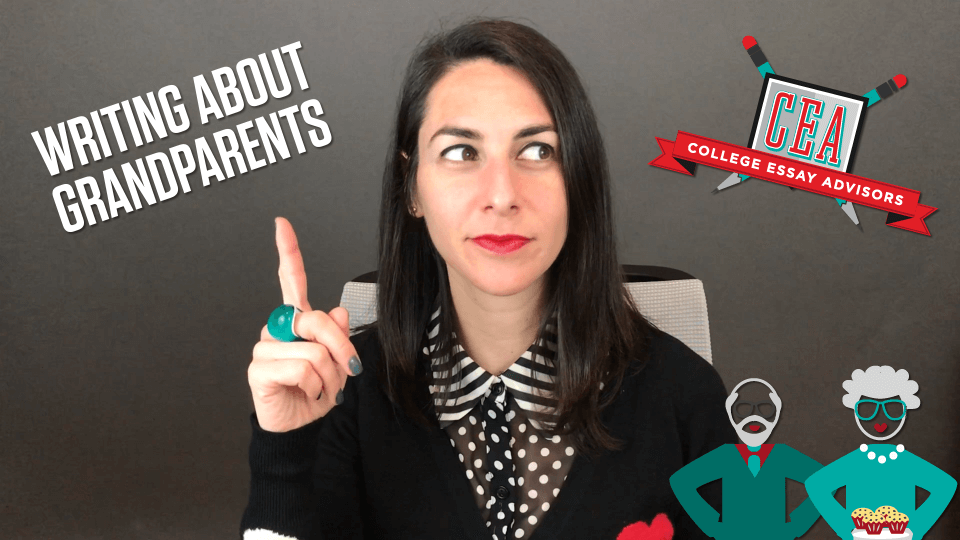
How to Write a Unique College Essay About a Grandparent
So you just can’t shake the voice in your head telling you to write your college admissions essay about your grandma. We get it, grandparents are awesome! They know so much about you! And you’ve gained so much wisdom from your relationship with them! Writing a great personal statement or supplemental essay about them, however, is tricky. Luckily for you, CEA's Founder and Chief Advisor, Stacey Brook, is here to help you make sure your essay stands out.
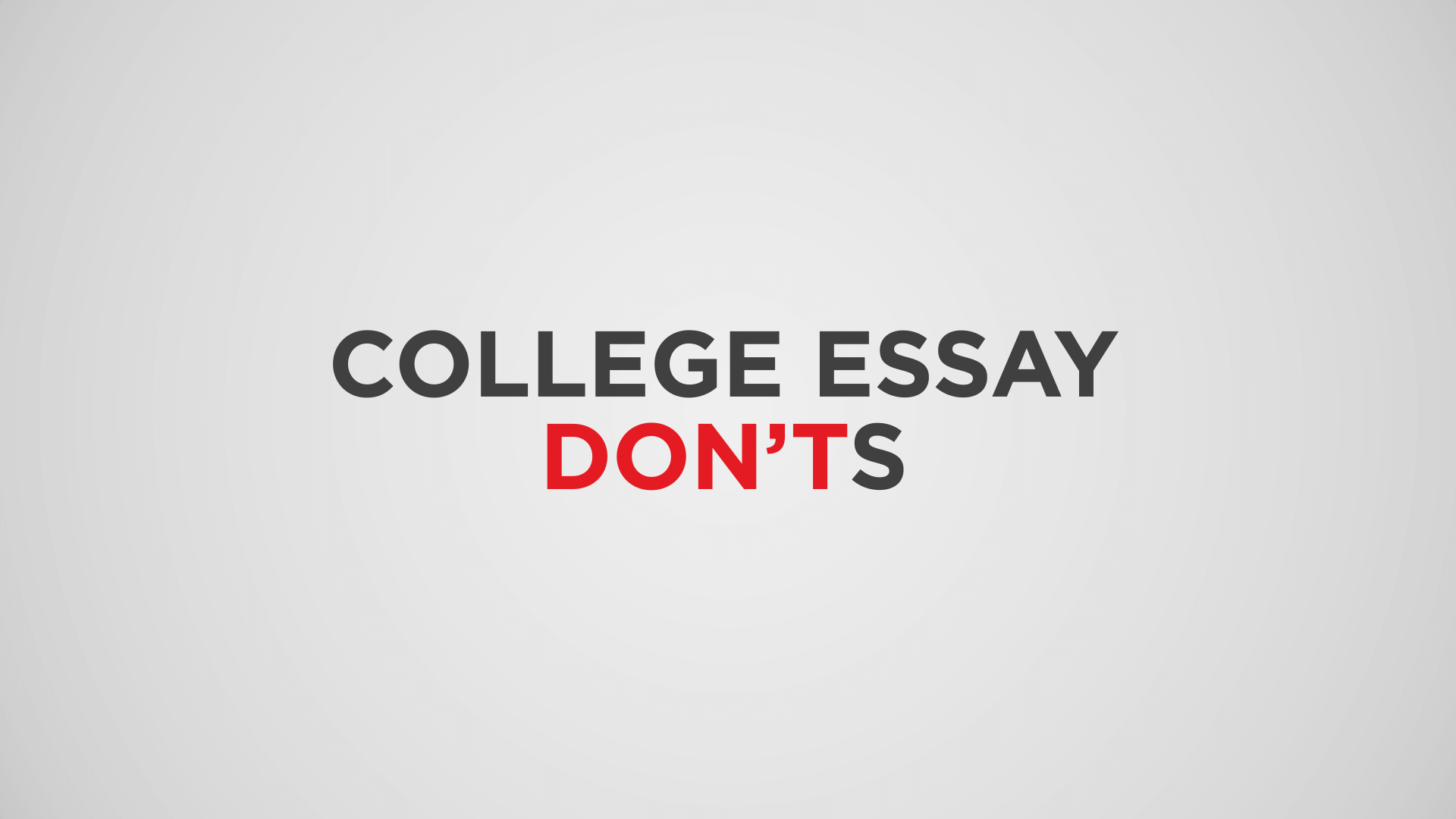
10 Things You Should NEVER Write in Your College Essay
In this video, we will walk you through the top 10 DON'Ts of the college admissions essay writing process, so you can submit your Common App personal statement and school-specific supplemental essays with the utmost confidence! This video will teach you: what not to write under any circumstance (or most circumstances), the mistakes applicants make without even realizing, and more!
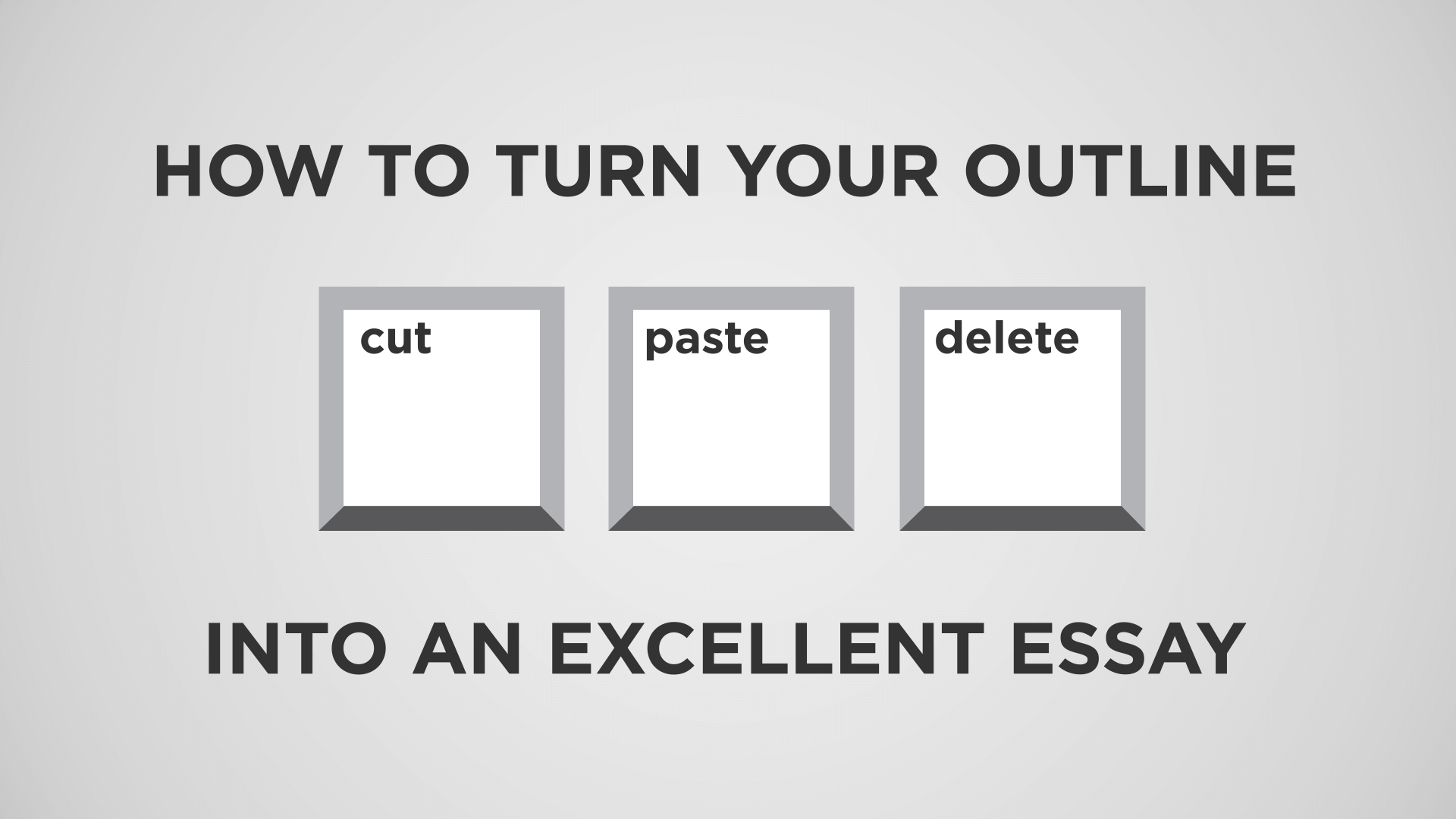
How to Turn your Outline into a Stellar Essay
Structuring a winning college admissions essay is hard. Should you start with the ending and then catch the reader up? Or throw them head first into the action and explain later? And where exactly should you put all of great sentences, you've come up with thus far? In this video, we'll teach you everything you need to know about turning your outline into a rough draft!
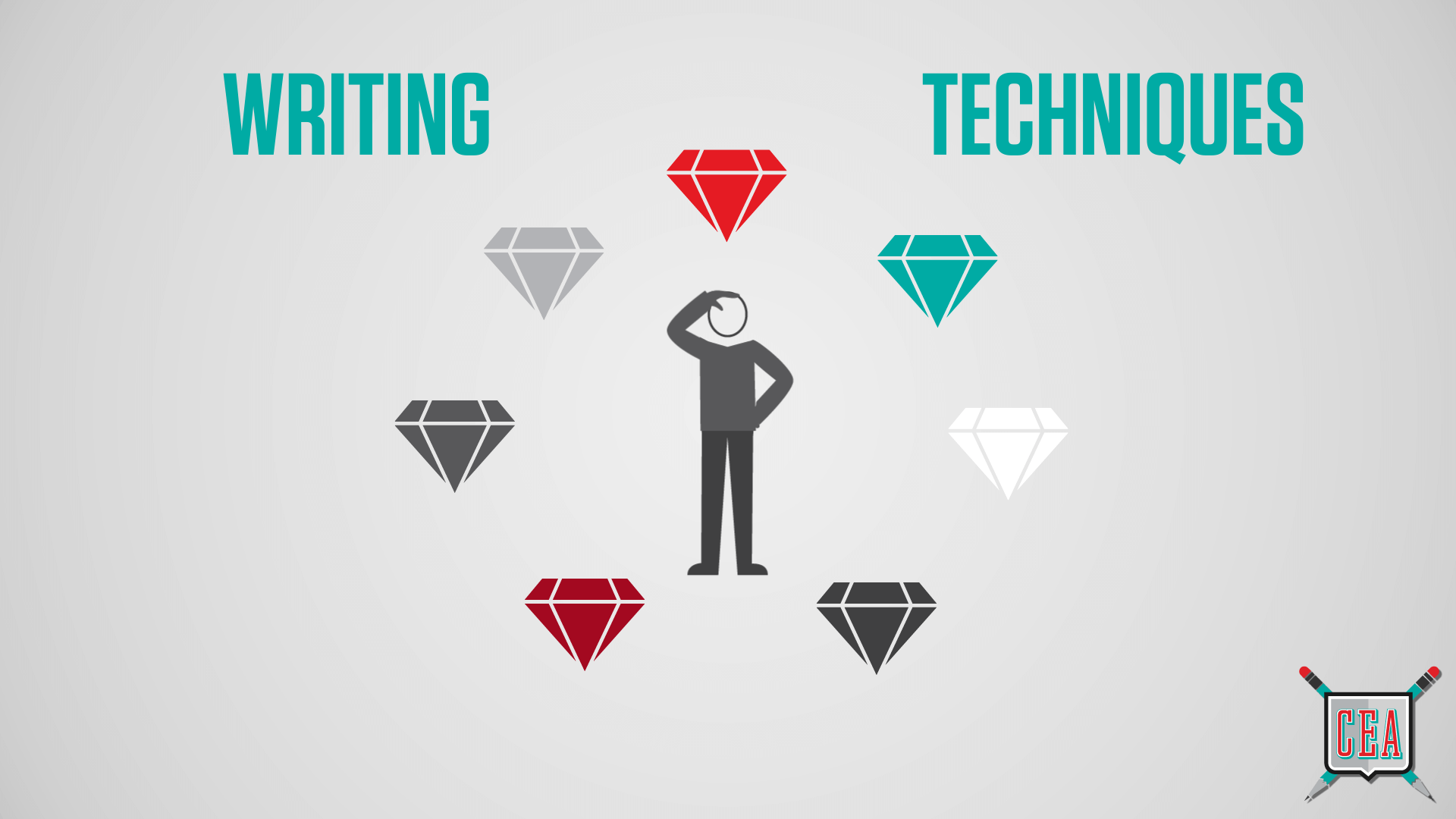
Freewriting, Topic Selection, and the First Draft
Freewriting is the key to an amazing college application essay - especially the first draft! Fill up you blank page (or text box) with these tips for getting started (and never stopping) on your way to personal statement success.
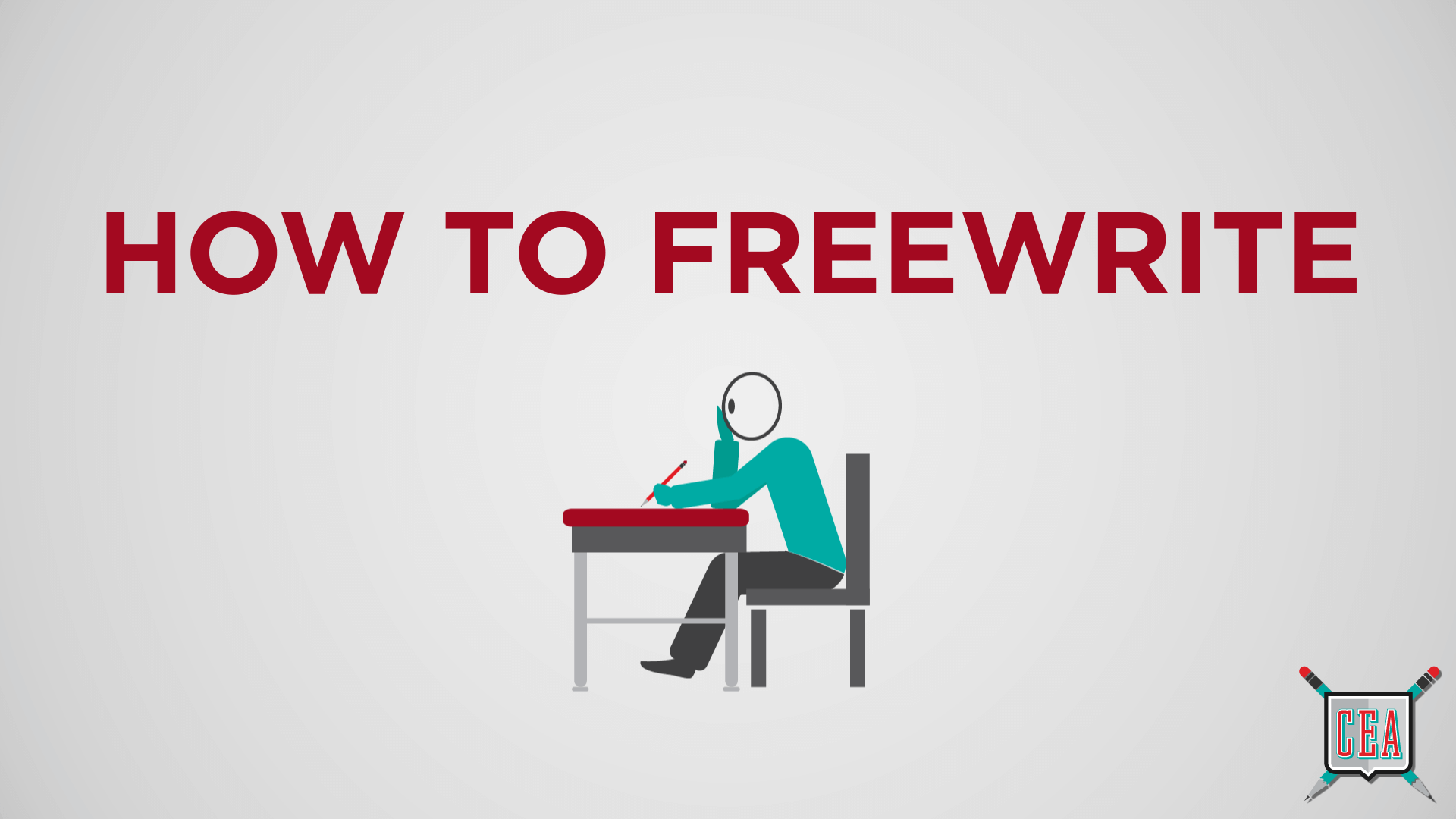
Freewriting 101: How to Freewrite for Your College Essay
Freewriting is, at its core, just as it sounds: the act of writing freely. It is the exercise of jotting down whatever comes to mind, without judgment or worrying about the final product. Because the college admissions essay holds so much weight, many students struggle with the 'no judgement' part. This video will show you how to put your inner critic aside and let the writing flow.
![personal statement rough draft How do You Know When You’ve Found THE Winning Topic? [TAKE THE TEST]](https://www.collegeessayadvisors.com/wp-content/uploads/2019/06/Youtube_Ch3Row11_Thumb.png)
How do You Know When You’ve Found THE Winning Topic? [TAKE THE TEST]
How do you know when you've found THE topic? You know, the topic that will rule all other topics. The one that will make admissions officers laugh or cry...or both? Does your topic have what it takes to make you stand out from a sea of similarly qualified applicants? This video is here to help you put your topic to the test.
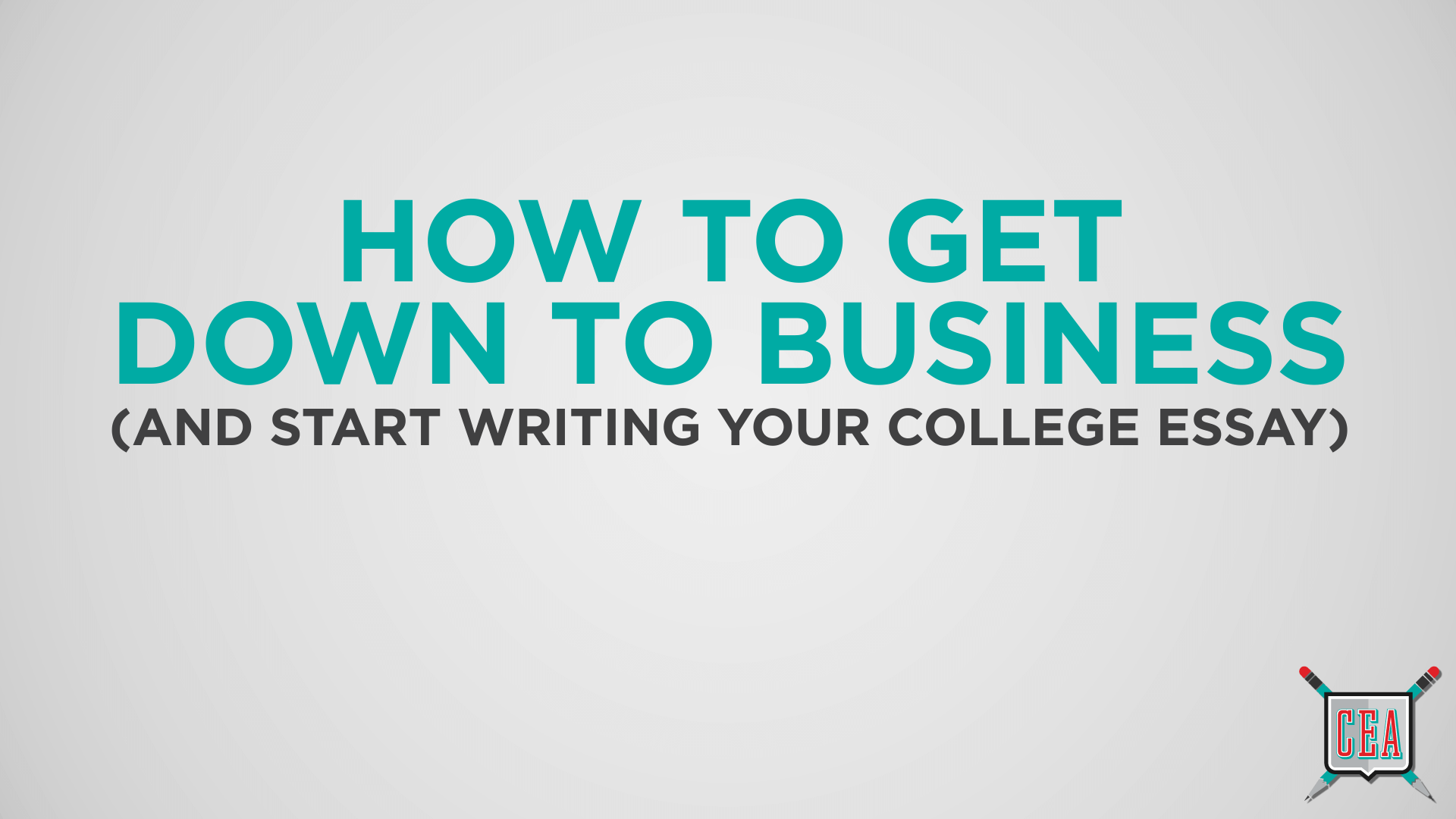

How to Begin the College Essay Writing Process
One of the hardest parts of writing the college application essay is getting started. Where is the best place to begin? What does admissions really want to hear from you? And how do you know if you’re moving in the right direction? We made this video full of helpful tips to help you break through your initial writing blocks and get you on the road to college essay success.
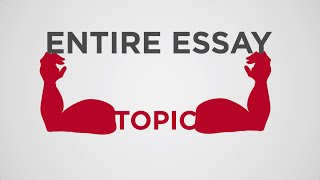
How To Outline Your Personal Statement
Extracting a killer college application essay from your notes, brainstorms, and freewrites may seem like a daunting task. You love your topic, but your ideas are scattered. That's why outlining is your friend.
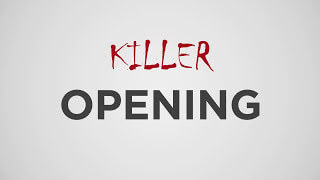
The Trick to Writing an Amazing Opening Line
The personal statement is a crucial part of your college application, but it won't help you if it bores admissions officers to tears! Learn the do's and don'ts of how to write a powerful opening line that pulls your reader in from the very first word.
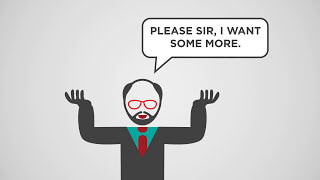
How To Write a Memorable Closing Line
Your personal statement should tell a memorable story that admissions officers just can't shake. Your closing line is your final shot to make a lasting impression before your college fate is sealed! The experts at College Essay Advisors have lined up their most essential tips for writing a killer closing line.
- Our Approach & Team
- Undergraduate Testimonials
- Postgraduate Testimonials
- Where Our Students Get In
- CEA Gives Back
- Undergraduate Admissions
- Graduate Admissions
- Private School Admissions
- International Student Admissions
- Common App Essay Guide
- Supplemental Essay Guides
- Coalition App Guide
- The CEA Podcast
- YouTube Tutorials
- Admissions Stats
- Notification Trackers
- Deadline Databases
- College Essay Examples
- Academy and Worksheets
- Get Started
Purdue Online Writing Lab Purdue OWL® College of Liberal Arts
Writing the Personal Statement

Welcome to the Purdue OWL
This page is brought to you by the OWL at Purdue University. When printing this page, you must include the entire legal notice.
Copyright ©1995-2018 by The Writing Lab & The OWL at Purdue and Purdue University. All rights reserved. This material may not be published, reproduced, broadcast, rewritten, or redistributed without permission. Use of this site constitutes acceptance of our terms and conditions of fair use.
This handout provides information about writing personal statements for academic and other positions.
The personal statement, your opportunity to sell yourself in the application process, generally falls into one of two categories:
1. The general, comprehensive personal statement:
This allows you maximum freedom in terms of what you write and is the type of statement often prepared for standard medical or law school application forms.
2. The response to very specific questions:
Often, business and graduate school applications ask specific questions, and your statement should respond specifically to the question being asked. Some business school applications favor multiple essays, typically asking for responses to three or more questions.
Questions to ask yourself before you write:
- What's special, unique, distinctive, and/or impressive about you or your life story?
- What details of your life (personal or family problems, history, people or events that have shaped you or influenced your goals) might help the committee better understand you or help set you apart from other applicants?
- When did you become interested in this field and what have you learned about it (and about yourself) that has further stimulated your interest and reinforced your conviction that you are well suited to this field? What insights have you gained?
- How have you learned about this field—through classes, readings, seminars, work or other experiences, or conversations with people already in the field?
- If you have worked a lot during your college years, what have you learned (leadership or managerial skills, for example), and how has that work contributed to your growth?
- What are your career goals?
- Are there any gaps or discrepancies in your academic record that you should explain (great grades but mediocre LSAT or GRE scores, for example, or a distinct upward pattern to your GPA if it was only average in the beginning)?
- Have you had to overcome any unusual obstacles or hardships (for example, economic, familial, or physical) in your life?
- What personal characteristics (for example, integrity, compassion, and/or persistence) do you possess that would improve your prospects for success in the field or profession? Is there a way to demonstrate or document that you have these characteristics?
- What skills (for example, leadership, communicative, analytical) do you possess?
- Why might you be a stronger candidate for graduate school—and more successful and effective in the profession or field than other applicants?
- What are the most compelling reasons you can give for the admissions committee to be interested in you?
General advice
Answer the questions that are asked
- If you are applying to several schools, you may find questions in each application that are somewhat similar.
- Don't be tempted to use the same statement for all applications. It is important to answer each question being asked, and if slightly different answers are needed, you should write separate statements. In every case, be sure your answer fits the question being asked.
Tell a story
- Think in terms of showing or demonstrating through concrete experience. One of the worst things you can do is to bore the admissions committee. If your statement is fresh, lively, and different, you'll be putting yourself ahead of the pack. If you distinguish yourself through your story, you will make yourself memorable.
Be specific
- Don't, for example, state that you would make an excellent doctor unless you can back it up with specific reasons. Your desire to become a lawyer, engineer, or whatever should be logical, the result of specific experience that is described in your statement. Your application should emerge as the logical conclusion to your story.
Find an angle
- If you're like most people, your life story lacks drama, so figuring out a way to make it interesting becomes the big challenge. Finding an angle or a "hook" is vital.
Concentrate on your opening paragraph
- The lead or opening paragraph is generally the most important. It is here that you grab the reader's attention or lose it. This paragraph becomes the framework for the rest of the statement.
Tell what you know
- The middle section of your essay might detail your interest and experience in your particular field, as well as some of your knowledge of the field. Too many people graduate with little or no knowledge of the nuts and bolts of the profession or field they hope to enter. Be as specific as you can in relating what you know about the field and use the language professionals use in conveying this information. Refer to experiences (work, research, etc.), classes, conversations with people in the field, books you've read, seminars you've attended, or any other source of specific information about the career you want and why you're suited to it. Since you will have to select what you include in your statement, the choices you make are often an indication of your judgment.
Don't include some subjects
- There are certain things best left out of personal statements. For example, references to experiences or accomplishments in high school or earlier are generally not a good idea. Don't mention potentially controversial subjects (for example, controversial religious or political issues).
Do some research, if needed
- If a school wants to know why you're applying to it rather than another school, do some research to find out what sets your choice apart from other universities or programs. If the school setting would provide an important geographical or cultural change for you, this might be a factor to mention.
Write well and correctly
- Be meticulous. Type and proofread your essay very carefully. Many admissions officers say that good written skills and command of correct use of language are important to them as they read these statements. Express yourself clearly and concisely. Adhere to stated word limits.
Avoid clichés
- A medical school applicant who writes that he is good at science and wants to help other people is not exactly expressing an original thought. Stay away from often-repeated or tired statements.
For more information on writing a personal statement, see the personal statement vidcast .

- Previous Article
- Next Article
Writing and Structuring
Ten steps for writing an exceptional personal statement.
- Split-Screen
- Article contents
- Figures & tables
- Supplementary Data
- Peer Review
- Open the PDF for in another window
- Guest Access
- Get Permissions
- Cite Icon Cite
- Search Site
Danielle Jones , J. Richard Pittman , Kimberly D. Manning; Ten Steps for Writing an Exceptional Personal Statement. J Grad Med Educ 1 October 2022; 14 (5): 522–525. doi: https://doi.org/10.4300/JGME-D-22-00331.1
Download citation file:
- Ris (Zotero)
- Reference Manager
The personal statement is an important requirement for residency and fellowship applications that many applicants find daunting. Beyond the cognitive challenge of writing an essay, time limitations for busy senior residents on clinical rotations present added pressure. Objective measures such as scores and evaluations paint only a partial picture of clinical and academic performance, leaving gaps in a candidate's full portrait. 1 , 2 Applicants, seemingly similar on paper, may have striking differences in experiences and distances traveled that would not be captured without a personal narrative. 2 , 3 We recommend, therefore, reframing personal statements as the way to best highlight applicants' greatest strengths and accomplishments. A well-written personal statement may be the tipping point for a residency or fellowship interview invitation, 4 , 5 which is particularly important given the heightened competition for slots due to increased participation on virtual platforms. Data show that 74% to 78% of residency programs use personal statements in their interview selection process, and 48% to 54% use them in the final rank. 6 , 7 With our combined 50 years of experience as clerkship and residency program directors (PDs) we value the personal statement and strongly encourage our trainees to seize the opportunity to feature themselves in their words.
Our residency and medical school leadership roles position us to edit and review numerous resident and student personal statements annually. This collective experience has helped us identify patterns of struggle for trainees: trouble starting, difficulty organizing a cogent narrative, losing the “personal” in the statement, and failing to display unique or notable attributes. While a bland personal statement may not hurt an applicant, it is a missed opportunity. 4 , 8 We also have distinguished helpful personal statement elements that allow PDs to establish candidates' “fit” with their desired residency or fellowship. A recent study supports that PDs find unique applicant information from personal statements helpful to determine fit. 4 Personal statement information also helps programs curate individualized interview days (eg, pair interviewers, guide conversations, highlight desirable curricula). Through our work with learners, we developed the structured approach presented here ( Figure 1 ). Applicants can use our approach to minimize typical struggles and efficiently craft personal statements that help them stand out. Busy residents, particularly, have minimal time to complete fellowship applications. We acknowledge there is no gold standard or objective measures for effective personal statement preparation. 9 Our approach, however, combined with a practical tool ( Figure 2 ), has streamlined the process for many of our mentees. Moreover, faculty advisors and program leaders, already challenged by time constraints, can use this tool to enhance their coaching and save time, effort, and cognitive energy.

Structured Approach to Writing a Personal Statement

Ten Steps for Writing an Exceptional Personal Statement: Digital Tool
Note: Use the QR code to download the digital tool and follow the 10 steps highlighted in Figure 1.
Given word count and space limitations, deciding what to include in a personal statement can be challenging. An initial brainstorm helps applicants recall personal attributes and experiences that best underscore key strengths (Step 1). 10 Writing explicit self-affirmations is challenging, so we recommend pairing with a near peer who may offer insight. Useful prompts include:
What 3 words best encapsulate me?
What accomplishments make me proud?
What should every program know about me?
Reflecting on these questions (Step 2) helps elucidate the foundations of the narrative, 10 including strengths, accomplishments, and unique elements to be included. Additionally, the preparation steps help uncover the “thread” that connects the story sequentially. While not all agree that personal or patient stories are necessary, they are commonly included. 5 One genre analysis showed that 97% of applicants to residency programs in internal medicine, family medicine, and surgery used an opening that included either a personal narrative (66%) and/or a decision to enter medicine (54%) or the specialty of choice (72%). 9 Radiology PDs ranked personal attributes as the second most important component in personal statements behind choice of specialty. 9 Further, a descriptive study of anesthesia applicants' personal statements ranked those that included elements such as discussion of a family's or friend's illness or a patient case as more original. 3 We feel that personal and patient stories often provide an interesting hook to engage readers, as well as a mechanism to highlight (1) personal characteristics, (2) journey to and/or enthusiasm for desired discipline, and (3) professional growth, all without giving the impression of being boastful. Sketching these Step 2 fundamentals prepares applicants to begin writing with intention.
Once key elements are identified, the next steps assist with the actual writing. Utilizing information gleaned from the “Preparing” steps, start with a freewriting exercise (Step 3), an unrestricted association of ideas aimed at answering, “What experiences have cultivated my strong interest in pursuing [______]?” At this stage, ignore spelling and grammar. Just write, even if the product is the roughest, rough draft imaginable. 10 Setting a timer for 10 to 15 minutes establishes a less intimidating window to start. Freewriting generates the essential initial content that typically will require multiple revisions. 10
Next, we recommend structuring the freewriting content into suggested paragraphs (Step 4), using the following framework to configure the first draft:
Introductory paragraph: A compelling story, experience, or something that introduces the applicant and makes the reader want to know more (the hook). If related to a patient or other person, it should underscore the writer's qualities.
Paragraph 2: Essential details that a program must know about the applicant and their proudest accomplishments.
Paragraph(s) 3-4: Specific strengths related to the specialty of choice and leadership experiences.
Closing paragraph: What the applicant values in a training program and what they believe they can contribute.
Evaluate what has been written and ensure that, after the engaging hook, the body incorporates the best pieces identified during the preparation steps (Step 5). A final paragraph affords ample space for a solid conclusion to the thread. Occasionally the narrative flows better with separate strengths and leadership paragraphs for a total of 5, but we strongly recommend the final statement not exceed 1 single-spaced page to reduce cognitive load on the reader.
This part of the process involves revising the piece into a final polished personal statement. Before an early draft is shared with others, it should be evaluated for several important factors by returning to the initial questions and then asking (Step 6):
“Does this personal statement…”
Amplify my strengths, highlight my proudest accomplishments, and emphasize what a program must know about me?
Have a logical flow?
Accurately attribute content and avoid plagiarism?
Use proper grammar and avoid slang or profanity?
While not as challenging as the other steps, optimization takes time. 10 At this stage, “resting” the draft for 1 week minimum (Step 7) puts a helpful distance between the writer and their work before returning, reading, and editing. 10 Writers can edit their own work to a point, but they often benefit by enlisting a trusted peer or advisor for critiques. Hearing their draft read aloud by a peer or advisor allows the applicant to evaluate the work from another perspective while noting how well it meets the criteria from the tool (provided as online supplementary data).
A virtual or in-person meeting between applicant and mentor ultimately saves time and advances the writer to a final product more quickly than an email exchange. Sending the personal statement in advance helps facilitate the meeting. Invite the advisor to candidly comment on the tool's criteria to yield the most useful feedback (Step 8). When done effectively, edits can be made in real time with the mentor's input.
We bring closure to the process by focusing on spelling and grammar checks (Step 9). Clarity, conciseness, and the use of proper English were rated as extremely important by PDs. 3 , 9 Grammatical errors distract readers, highlight inattention to detail, and detract from the personal statement. 3 , 9 Once more, we recommend resting the draft before calling it final (Step 10). If the piece required starting over or significant rewriting based on feedback received, we also suggest seeking additional feedback on this draft, ideally from someone in the desired residency or fellowship discipline. If only minor edits (eg, flow, language) were incorporated, the personal statement can be considered complete at this time.
Writing a personal statement represents a unique opportunity for residency and fellowship applicants to amplify their ERAS application beyond the confines of its objective components. 3 Using this stepwise approach encourages each personal statement to be truly personal and streamlines the process for applicants and reviewers alike. All stakeholders benefit: applicants, regardless of their scores and academic metrics, can arm themselves with powerful means for self-advocacy; PDs gain a clearer idea of individual applicants, allowing them to augment the selection process and curate the individual interview day; and faculty mentors can offer concrete direction to every mentee seeking their help.
Recipient(s) will receive an email with a link to 'Ten Steps for Writing an Exceptional Personal Statement' and will not need an account to access the content.
Subject: Ten Steps for Writing an Exceptional Personal Statement
(Optional message may have a maximum of 1000 characters.)
Citing articles via
Never miss an issue, get new journal tables of contents sent right to your email inbox.
- Submit an Article
Affiliations

- eISSN 1949-8357
- ISSN 1949-8349
- Privacy Policy
- Get Adobe Acrobat Reader
This Feature Is Available To Subscribers Only
Sign In or Create an Account
Home — Essay Samples — Life — Personality — Personal Narrative Rough Draft
Personal Narrative Rough Draft
- Categories: Personality
About this sample

Words: 727 |
Published: Mar 19, 2024
Words: 727 | Pages: 2 | 4 min read
Table of contents
I. introduction, a. before diving into the intricacies of writing a personal narrative rough draft, it's essential to understand the significance of personal narratives themselves., b. thesis statement: the personal narrative rough draft is an essential step in the writing process that allows for exploration and reflection., ii. the purpose of the personal narrative rough draft, a. the personal narrative rough draft serves as a space for brainstorming and idea generation., b. furthermore, the rough draft helps writers organize their thoughts and ideas., c. additionally, the rough draft serves as a starting point for revising and refining the narrative., reflecting on the rough draft, a. revising for clarity and coherence:, b. seeking feedback from peers or instructors:, c. identifying areas for improvement and revision:, challenges and strategies for overcoming them, a. writer's block and lack of inspiration:, b. struggles with self-criticism and perfectionism:, c. techniques for overcoming challenges:, a. in conclusion, the personal narrative rough draft is a crucial step in the writing process that allows for exploration and reflection., b. remember to revise for clarity and coherence, seek feedback from others, and identify areas for improvement during the rough draft stage., c. ultimately, the personal narrative rough draft is not only a stepping stone towards a polished final product but also a journey of self-discovery and creative expression..

Cite this Essay
Let us write you an essay from scratch
- 450+ experts on 30 subjects ready to help
- Custom essay delivered in as few as 3 hours
Get high-quality help

Dr. Heisenberg
Verified writer
- Expert in: Life

+ 120 experts online
By clicking “Check Writers’ Offers”, you agree to our terms of service and privacy policy . We’ll occasionally send you promo and account related email
No need to pay just yet!
Related Essays
4 pages / 1839 words
6 pages / 2538 words
2 pages / 736 words
3 pages / 1501 words
Remember! This is just a sample.
You can get your custom paper by one of our expert writers.
121 writers online
Still can’t find what you need?
Browse our vast selection of original essay samples, each expertly formatted and styled
Related Essays on Personality
Personality, the unique combination of thoughts, behaviors, and emotions that make each individual distinct, is a complex interplay between genetics and environment. While genetics provide the foundation, the environment plays a [...]
Cain, Susan. Quiet: The Power of Introverts in a World That Can't Stop Talking. Crown Publishers, 2012.
Through this experience, I became a more confident individual. My transformation benefited me in all spheres of my life: sports, family affairs, and academics. I display true sportsmanship in each game, patience and acceptance [...]
Writing an essay describing yourself is like gazing into a mirror, attempting to capture the complex facets that compose your identity. It is an introspective journey that transcends the surface, delving into the core of your [...]
Chang, E. (2016). The power of an open mind. Journal of Positive Psychology, 11(5), 569-571.Greene, J. D. (2013). Moral tribes: Emotion, reason, and the gap between us and them. Penguin Books.Krumrei-Mancuso, E. J., & Rouse, S. [...]
Frida Kahlo, the most famous female artist to date. Frida was a confident and brave woman, especially for her time. She didn’t let anyone tell her what she could and could not accomplish. Even through her personal troubles, she [...]
Related Topics
By clicking “Send”, you agree to our Terms of service and Privacy statement . We will occasionally send you account related emails.
Where do you want us to send this sample?
By clicking “Continue”, you agree to our terms of service and privacy policy.
Be careful. This essay is not unique
This essay was donated by a student and is likely to have been used and submitted before
Download this Sample
Free samples may contain mistakes and not unique parts
Sorry, we could not paraphrase this essay. Our professional writers can rewrite it and get you a unique paper.
Please check your inbox.
We can write you a custom essay that will follow your exact instructions and meet the deadlines. Let's fix your grades together!
Get Your Personalized Essay in 3 Hours or Less!
We use cookies to personalyze your web-site experience. By continuing we’ll assume you board with our cookie policy .
- Instructions Followed To The Letter
- Deadlines Met At Every Stage
- Unique And Plagiarism Free
- PRO Courses Guides New Tech Help Pro Expert Videos About wikiHow Pro Upgrade Sign In
- EDIT Edit this Article
- EXPLORE Tech Help Pro About Us Random Article Quizzes Request a New Article Community Dashboard This Or That Game Popular Categories Arts and Entertainment Artwork Books Movies Computers and Electronics Computers Phone Skills Technology Hacks Health Men's Health Mental Health Women's Health Relationships Dating Love Relationship Issues Hobbies and Crafts Crafts Drawing Games Education & Communication Communication Skills Personal Development Studying Personal Care and Style Fashion Hair Care Personal Hygiene Youth Personal Care School Stuff Dating All Categories Arts and Entertainment Finance and Business Home and Garden Relationship Quizzes Cars & Other Vehicles Food and Entertaining Personal Care and Style Sports and Fitness Computers and Electronics Health Pets and Animals Travel Education & Communication Hobbies and Crafts Philosophy and Religion Work World Family Life Holidays and Traditions Relationships Youth
- Browse Articles
- Learn Something New
- Quizzes Hot
- This Or That Game New
- Train Your Brain
- Explore More
- Support wikiHow
- About wikiHow
- Log in / Sign up
- Education and Communications
- Fiction Writing
- Writing Novels
How to Write a Rough Draft
Last Updated: February 6, 2023 Fact Checked
This article was co-authored by Michelle Golden, PhD . Michelle Golden is an English teacher in Athens, Georgia. She received her MA in Language Arts Teacher Education in 2008 and received her PhD in English from Georgia State University in 2015. There are 10 references cited in this article, which can be found at the bottom of the page. This article has been fact-checked, ensuring the accuracy of any cited facts and confirming the authority of its sources. This article has been viewed 294,299 times.
Writing a rough draft is an essential part of the writing process, an opportunity to get your initial ideas and thoughts down on paper. It might be difficult to dive right into a rough draft of an essay or a creative piece, such as a novel or a short story. You should start by brainstorming ideas for the draft to get your creative juices flowing and take the time to outline your draft. You will then be better prepared to sit down and write your rough draft.
Brainstorming Ideas for the Draft

- Freewrites often work best if you give yourself a time limit, such as five minutes or ten minutes. You should then try to not take your pen off the page as you write so you are forced to keep writing about the subject or topic for the set period of time.
- For example, if you were writing an essay about the death penalty, you may use the prompt: “What are the possible issues or problems with the death penalty?” and write about it freely for ten minutes.
- Often, freewrites are also a good way to generate content that you can use later in your rough draft. You may surprised at what you realize as you write freely about the topic.

- To use the clustering method, you will place a word that describes your topic or subject in the center of your paper. You will then write keywords and thoughts around the center word. Circle the center word and draw lines away from the center to other keywords and ideas. Then, circle each word as you group them around the central word.
- For example, if you were trying to write a short story around a theme like “anger”, you will write “anger” in the middle of the page. You may then write keywords around “anger”, like “volcano”, “heat”, “my mother”, and “rage”.

- If you are writing a creative piece, you may look for texts written about a certain idea or theme that you want to explore in your own writing. You could look up texts by subject matter and read through several texts to get ideas for your story.
- You might have favorite writers that you return to often for inspiration or search for new writers who are doing interesting things with the topic. You could then borrow elements of the writer’s approach and use it in your own rough draft.
- You can find additional resources and texts online and at your local library. Speak to the reference librarian at your local library for more information on resources and texts.
Outlining Your Draft

- You may use the snowflake method to create the plot outline. In this method, you will write a one line summary of your story, followed by a one paragraph summary, and then character synopses. You will also create a spreadsheet of scenes.
- Alternatively, you can use a plot diagram. In this method, you will have six sections: the set up, the inciting incident, the rising action, the climax, the falling action, and the resolution.
- No matter which option you chose, you should make sure your outline contains at least the inciting incident, the climax, and the resolution. Having these three elements set in your mind will make writing your rough draft much easier.

- Act 1: In Act 1, your protagonist meets the other characters in the story. The central conflict of the story is also revealed. Your protagonist should also have a specific goal that will cause them to make a decision. For example, in Act 1, you may have your main character get bitten by a vampire after a one night stand. She may then go into hiding once she discovers she has become a vampire.
- Act 2: In Act 2, you introduce a complication that makes the central conflict even more of an issue. The complication can also make it more difficult for your protagonist to achieve their goal. For example, in Act 2, you may have your main character realize she has a wedding to go to next week for her best friend, despite the fact she has now become a vampire. The best friend may also call to confirm she is coming, making it more difficult for your protagonist to stay in hiding.
- Act 3: In Act 3, you present a resolution to the central conflict of the story. The resolution may have your protagonist achieve their goal or fail to achieve their goal. For example, in Act 3, you may have your protagonist show up to the wedding and try to pretend to not be a vampire. The best friend may then find out and accept your protagonist anyway. You may end your story by having your protagonist bite the groom, turning him into her vampire lover.

- Section 1: Introduction, including a hook opening line, a thesis statement , and three main discussion points. Most academic essays contain at least three key discussion points.
- Section 2: Body paragraphs, including a discussion of your three main points. You should also have supporting evidence for each main point, from outside sources and your own perspective.
- Section 3: Conclusion, including a summary of your three main points, a restatement of your thesis, and concluding statements or thoughts.

- For example, maybe you are creating a rough draft for a paper on gluten-intolerance. A weak thesis statement for this paper would be, “There are some positives and negatives to gluten, and some people develop gluten-intolerance.” This thesis statement is vague and does not assert an argument for the paper.
- A stronger thesis statement for the paper would be, “Due to the use of GMO wheat in food sold in North America, a rising number of Americans are experiencing gluten-intolerance and gluten-related issues.” This thesis statement is specific and presents an argument that will be discussed in the paper.

- Your professor or teacher may require you to create a bibliography using MLA style or APA style. You will need to organize your sources based on either style.
Writing the Rough Draft

- You may also make sure the room is set to an ideal temperature for sitting down and writing. You may also put on some classical or jazz music in the background to set the scene and bring a snack to your writing area so you have something to munch on as you write.

- You may also write the ending of the essay or story before you write the beginning. Many writing guides advise writing your introductory paragraph last, as you will then be able to create a great introduction based on the piece as a whole.

- You should also try not to read over what you are writing as you get into the flow. Do not examine every word before moving on to the next word or edit as you go. Instead, focus on moving forward with the rough draft and getting your ideas down on the page.

- For example, rather than write, “It was decided by my mother that I would learn violin when I was two,” go for the active voice by placing the subject of the sentence in front of the verb, “My mother decided I would learn violin when I turned two.”
- You should also avoid using the verb “to be” in your writing, as this is often a sign of passive voice. Removing “to be” and focusing on the active voice will ensure your writing is clear and effective.

- You may also review the brainstorming materials you created before you sat down to write, such as your clustering exercise or your freewrite. Reviewing these materials could help to guide you as you write and help you focus on finishing the rough draft.
- You may want to take breaks if you find you are getting writer’s block. Going for a walk, taking a nap, or even doing the dishes can help you focus on something else and give your brain a rest. You can then start writing again with a fresh approach after your break.

- You should also read the rough draft out loud to yourself. Listen for any sentences that sound unclear or confusing. Highlight or underline them so you know they need to be revised. Do not be afraid to revise whole sections or lines of the rough draft. It is a draft, after all, and will only improve with revision.
- You can also read the rough draft out loud to someone else. Be willing to accept feedback and constructive criticism on the draft from the person. Getting a different perspective on your writing will often make it that much better.
Community Q&A
You Might Also Like

- ↑ https://www.umgc.edu/current-students/learning-resources/writing-center/online-guide-to-writing/tutorial/chapter2/ch2-13
- ↑ https://writing.ku.edu/prewriting-strategies
- ↑ https://academicguides.waldenu.edu/writingcenter/writingprocess/outlining
- ↑ http://www.writerswrite.com/screenwriting/cannell/lecture4/
- ↑ https://www.grammarly.com/blog/essay-outline/
- ↑ https://writingcenter.unc.edu/tips-and-tools/thesis-statements/
- ↑ https://writingcenter.unc.edu/tips-and-tools/editing-and-proofreading/
- ↑ https://www.grammarly.com/blog/rough-draft/
- ↑ https://writing.wisc.edu/handbook/style/ccs_activevoice/
- ↑ https://writingcenter.unc.edu/tips-and-tools/revising-drafts/
About This Article

To write a rough draft, don't worry if you make minor mistakes or write sentences that aren't perfect. You can revise them later! Also, try not to read over what you're writing as you go, which will slow you down and mess up your flow. Instead, focus on getting all of your thoughts and ideas down on paper, even if you're not sure you'll keep them in the final draft. If you get stuck, refer to your outline or sources to help you come up with new ideas. For tips on brainstorming and outlining for a rough draft, read on! Did this summary help you? Yes No
- Send fan mail to authors
Reader Success Stories
Oct 10, 2023
Did this article help you?
Eswaran Eswaran
Aug 24, 2016
Rishabh Nag
Aug 21, 2016
Oct 3, 2016
Mabel McDowell
Nov 17, 2017

Featured Articles

Trending Articles

Watch Articles

- Terms of Use
- Privacy Policy
- Do Not Sell or Share My Info
- Not Selling Info
Don’t miss out! Sign up for
wikiHow’s newsletter
Please turn on JavaScript in your browser It appears your web browser is not using JavaScript. Without it, some pages won't work properly. Please adjust the settings in your browser to make sure JavaScript is turned on.
What’s a personal statement for college.
Senior Associate, JPMorgan Chase

As you complete your college applications, whether it’s through the Common App or by individually applying, you’ll likely come across prompts in the application that ask you to write about yourself. Think of it as an opportunity to introduce yourself to the admissions committees of the schools you’re applying to in a different way than the insights recommendations and your transcript can provide.
Sometimes called an admissions or application essay, a personal statement, or a statement of purpose, what’s typically being asked for is information about your background, experiences, accomplishments, future goals, and any challenges or obstacles you may have had to overcome. Because of that, when it comes to any personal statements you write for college applications, the aim is usually to showcase your personality, interests, and character in a compelling and authentic way.
Keep reading for more information about personal statements, the prompts to expect, and some tips for mastering this part of a college application.
When will you have to write a personal statement during the college application process?
Many college applications require a personal statement of some kind. For applications submitted through the Common App, a personal statement is a required component for nearly all colleges and universities that use the platform. The Common App allows students to write one comprehensive essay that’s sent to all colleges they’re applying to through the system. This means you’ll write just one personal statement, which will be part of every college application you submit through the Common App. Some colleges might ask for additional shorter essays, known as supplemental essays, on top of this, so be prepared for those asks.
Many scholarship applications also require at least one personal statement or essay as part of the application process. Like college applications, scholarship personal statements provide an opportunity for applicants to showcase their qualifications, experiences, and personal motivations. A personal statement for a scholarship application often serves as a way for applicants to demonstrate their merit, express their career and educational goals, and explain how they’d benefit from and contribute to a scholarship program.
How can your personal statement impact your college applications?
Your personal statement can have a significant impact on your college applications in several ways:
- Demonstrating your character and personality: Your personal statement offers admission committees insight into who you are beyond your grades and test scores. It can showcase your values, motivations, and unique qualities, helping to paint a more comprehensive picture of you as a prospective student.
- Highlighting your achievements and experiences: It allows you to discuss your academic accomplishments, extracurriculars, and any challenges you’ve overcome. This can demonstrate your potential for success and your ability to contribute to a campus community.
- Conveying your passion and commitment to a particular school: A personal statement allows you to articulate your academic and career goals and connect them to your reasons for applying to a specific college or program. Admissions committees are looking for students who are genuinely interested in and committed to their educational and personal growth, along with being excited to attend their school.
- Setting you apart from other applicants: A well-crafted personal statement can help you stand out among applicants with similar academic credentials. It allows you to showcase what makes you unique.
- Addressing any weaknesses or challenges: If any aspects of your application may raise concerns to the admissions committees, such as a lower grade point average (GPA) in a particular semester, your personal statement can allow you to provide context and explain any extenuating circumstances. This can help mitigate potential red flags in your application.
How do you know what topic to write about in your personal statement?
Over 1,000 U.S. colleges accept the Common App, so many students will be choosing from among the Common App’s seven essay prompts.
Below is the list of essay prompts from 2023-24 Common App :
- “Some students have a background, identity, interest, or talent that is so meaningful they believe their application would be incomplete without it. If this sounds like you, then please share your story.”
- “The lessons we take from obstacles we encounter can be fundamental to later success. Recount a time when you faced a challenge, setback, or failure. How did it affect you, and what did you learn from the experience?”
- “Reflect on a time when you questioned or challenged a belief or idea. What prompted your thinking? What was the outcome?”
- “Reflect on something that someone has done for you that has made you happy or thankful in a surprising way. How has this gratitude affected or motivated you?”
- “Discuss an accomplishment, event, or realization that sparked a period of personal growth and a new understanding of yourself or others.”
- “Describe a topic, idea, or concept you find so engaging that it makes you lose all track of time. Why does it captivate you? What or who do you turn to when you want to learn more?”
- “Share an essay on any topic of your choice. It can be one you've already written, one that responds to a different prompt, or one of your own design.”
Beyond the prompts from the Common App, which many students utilize, some schools may have their own applications with their own prompts or supplementary prompts that they expect students to complete.
For instance, at Yale University , one of the school’s supplementary prompts is: “Tell us about a topic or idea that excites you and is related to one or more academic areas you selected above [on your application].” At Amherst College, one of the supplementary questions is: “In what ways could your unique experiences enhance our understanding of our nation and our world.”
What makes a good personal statement for a college application?
A lot goes into writing a strong personal statement for college applications.
Hafeez Lakhani of educational coaching firm Lakhani Coaching told the New York Times to think of it like this: “Every college is like a dinner table. What will make you the most interesting contributor to that dinner table conversation? What will make you help everyone else have a more interesting experience?”
Lacy Crawford, a former independent college application counselor and author of Early Decision, told USA Today : “These essays should read like smart, interesting 17-year-olds wrote them. A sense of perspective and self-awareness is what’s interesting...I think most students are torn between a pathway dividing a diary entry and a press release. It’s supposed to be a marketing document of the self.”
Here are a few tips to make the most of a personal statement.
- Tell a story: Use the space to showcase your personality, interests, personal values, life experiences, and even your sense of humor. Don’t just use it to regurgitate your accomplishments, which can be gleaned from your high school transcript and other parts of your application.
- Consider emphasizing your volunteer work and other community work: Many college admissions offices look for students who are active in their communities, be it volunteering or in different ways. The personal statement is a good place to emphasize how you’re making the world a better place.
- Emphasize any extra work you’ve done to dive into your field of interest: Be it internships, college-level courses at a community college, or extracurricular activities, anything that shows you’ve done extra work to explore your chosen field of study will help to emphasize your passion. Tie this passion to why you’re particularly excited about attending a particular school, and you may have a winning formula.
- Make sure you check grammar and spelling: You don’t want to write a great essay and let a few grammatical and spelling errors get in your way. Read and re-read your essay to check for spelling and grammar, and get a few people you trust to help you proofread your work as well.
Final thoughts
A strong personal statement can make a positive impression on admissions officers and contribute to a well-rounded and compelling college application. It allows you to showcase your strengths, demonstrate your potential, and express your genuine interest in the college or program.
Top 10 Personal Brand Statement Examples To Follow
Updated: March 11, 2024
Published: June 18, 2023
In a 2022 personal branding trends study, most respondents said they consider personal branding an essential component of work and their everyday life.

It found that 75% of Americans trust someone with a personal brand, and 63% are likely to buy from someone with a personal brand.
As an entrepreneur who is always on the lookout for customers or potential investors, you know that trust is key. Developing a personal brand for yourself can be an effective tool to help grow your business.
What is a personal brand statement?
A personal brand statement is a couple of sentences that highlights your unique skills and experience. It’s meant to be a quick introduction to people who discover you online because it summarizes what you can offer them.
Basically, it’s a catchphrase, tag line, or elevator pitch for you as a professional individual. While it showcases what you do professionally, you can also display your personality.
Why leaders should have a personal brand statement
You make a better first impression.
As the saying goes, “You only have one shot to make a first impression.” The challenge for entrepreneurs is that you don’t always know when that opportunity arises, as many first impressions happen online.
When a potential client or investor hears about you, their first instinct is to look up your social media profiles. If you’ve got a clear and well-thought-out personal brand statement, you’ve got a better chance at making them stick around for second and third impressions.
You can establish yourself as a thought leader
Thought leadership is a powerful content marketing tactic that can help you reach bigger audiences and generate leads for your business. When you’re known as a leader in your particular industry, that automatically gives you a higher level of credibility.
A personal brand statement can strengthen your thought leadership strategy by clearly stating your area of expertise.
You can create networking opportunities
Whether you’re looking for top talent, new clients, or potential investors, networking is half the battle.
Personal brand statements make it easy for potential connections to understand exactly what you do and what you value. Without it, you may miss out on opportunities simply because they didn’t know that you had something relevant to offer them.
Best personal brand statement examples for leaders
“bilingual creative who lives at the intersection of business & design.” —chris do.

Source: Chris Do’s LinkedIn page .
Chris Do is a multi-hyphenate: a designer, creative strategist, public speaker, founder, and CEO of The Futur, an online education platform.
What makes it great : Because he wears so many hats, Do’s personal branding statement is better than trying to explain everything he does.
“Helping people find their zen in the digital age.” —Shama Hyder
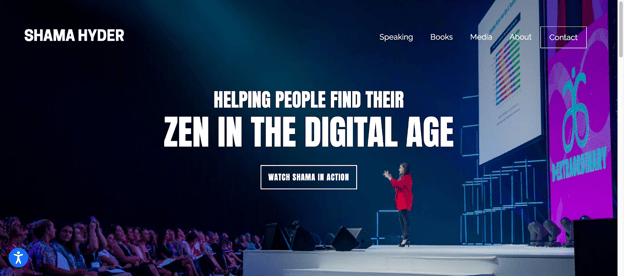
Source: Shama Hyder’s homepage .
Shama Hyder is the founder and CEO of Zen Media, a marketing and PR firm. She’s also written a book about digital marketing .
What makes it great : Hyder’s brand statement is an attention-grabbing play on her company’s name and showcases one of her key values: making clients feel a sense of calm in a fast-paced digital world.
“Write better sales emails faster with our in-inbox coach.” —Will Allred

Source: Will Allred’s LinkedIn page .
Will Allred is the co-founder of Lavender, an AI-powered email software startup.
What makes it great : Brooklin Nash, CEO of Beam Content, shares, “In one sentence, Allred captures the entire focus of his social presence: to help salespeople write better emails faster while demonstrating his authority and sharing his product in the second part of that headline.”
“Keeping it awkward, brave, and kind.” —Brené Brown
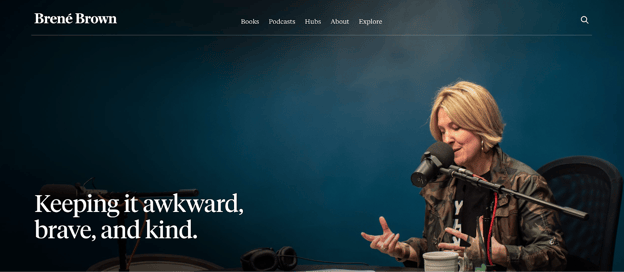
Source: Dr. Brené Brown’s homepage .
Brené Brown has a Ph.D. in sociology and is the author of several books that cover topics like shame, vulnerability, empathy, and courage.
What makes it great : Dr. Brown’s personal brand statement embodies her mission statement of encouraging people to embrace their vulnerabilities by sharing her own.
“Empowering ridiculously good marketing.” —Ann Handley

Source: Ann Handley’s homepage .
Ann Handley is a digital marketing expert and bestselling author. Her company helps marketers get tangible results.
What makes it great : Sharon Jonah, creative director and founder of digital marketing agency Buzz Social, shares, “In four words, we understand what Handley does, how she does it, whom she’s speaking to, and how she speaks.”
“Still just a girl who wants to learn. Youngest-ever Nobel laureate, co-founder @malalafund and president of Extracurricular Productions.” —Malala Yousafzai

Source: Malala Yousafzai’s Twitter profile .
Malala Yousafzai is the youngest Nobel laureate and an activist whose fund aims to remove the barriers to female education around the world.
What makes it great : Her bio highlights her impressive achievements with language that makes her sound relatable.
“Marketing. Strategy. Humanity.” —Mark Schaefer
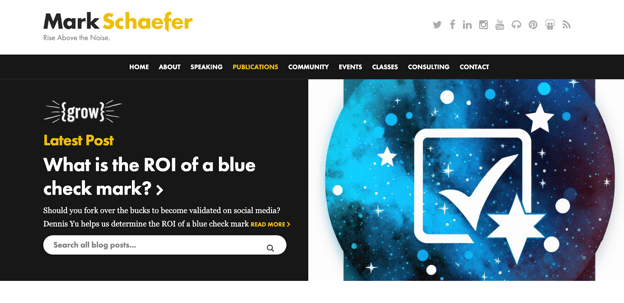
Source: Mark Schaefer’s homepage .
Mark Schaefer is an educator, speaker, marketing consultant, and author. He’s developed corporate marketing strategies for brands like Microsoft, IBM, and AT&T.
What makes it great : “It’s subtle, concise, and creative. It describes what Schaefer does, what he focuses on, and his unique and distinguished approach,” says Omer Usanmaz, CEO and co-founder of mentoring and learning software Qooper.
“Empowering successful women to take control of their finances.” —Jennifer Welsh
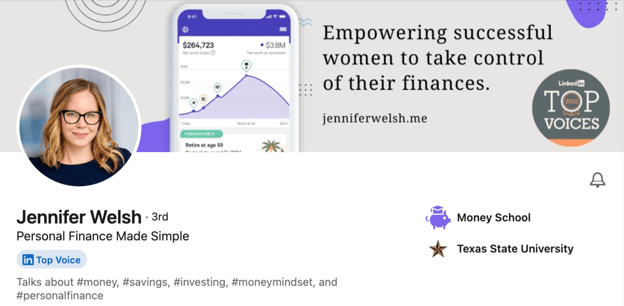
Source: Jennifer Welsh’s LinkedIn profile page .
Jennifer Welsh founded Money School, a digital course that teaches women about personal finance. What makes it great : Welsh’s strong personal brand statement says exactly what she does and whom she does it for.
“Let’s make Excel the solution, not the problem.” —Kat Norton (Miss Excel)

Source: Miss Excel’s homepage .
Kat Norton (known as Miss Excel) became famous on TikTok for her bite-sized Microsoft Excel tutorials. She now offers Excel courses on her website.
What makes it great : Norton’s clever statement shows that she understands her audience's problem and highlights her personality.
“‘The Customer Whisperer.’ I help marketers discover the hidden reasons why customers buy so they can become un-ignorable.” —Katelyn Bourgoin
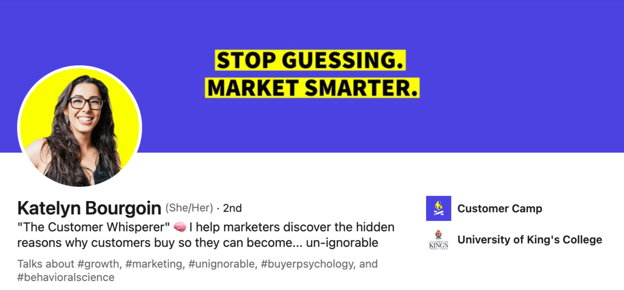
Source: Katelyn Bourgoin’s LinkedIn page .
Katelyn Bourgoin is a creator and serial entrepreneur who founded a branding agency, a mentoring platform for female entrepreneurs, and a restaurant consulting firm. She trains entrepreneurs to uncover what makes their products “un-ignorable.”
What makes it great : Bourgoin’s clever branding statement effectively tells marketers that she can help them understand their customers better and make their brands memorable.
How to write a personal brand statement
Writing an effective personal brand statement can be tough because it requires you to be catchy yet compelling. It should give audiences all the necessary information in a sentence or two.
Here are some tips for writing your own:
Think about your unique value proposition
A unique value proposition (or unique selling point) is what makes you different. It tells people why they should try your product or service, network with you, or invest in your business.
Tip : Identify your core values, goals, and strengths.
If you don't know what those are, ask yourself:
- Why am I building my brand?
- What do I want my audience to know me for?
- How do I do things differently?
- Do I have a distinct skill set, experience, point of view, or passion?
- What value do I bring to my audience?
Keep it short and sweet
Your brand statement should be simple and easy to understand.
The goal is to have someone look at your profile or website and immediately understand who you are and what you do, so keep it brief. Keep in mind that you don’t need full sentences either.
Start by writing one to three sentences that outline what you do, for whom, and how you do it. You can also add a sentence about values.
Then, look at different ways you can shorten them. Or pick out the most specific and impactful words and see what happens when you simply list them.
Showcase your personality
Injecting your personality empowers you to share what you do without being bland or boring. Being authentic also helps attract like-minded customers, investors, and peers.
At the end of the day, there are other people out there who may offer similar services or solve the same problems for your target audience. Your personality can set you apart.
“Don't be afraid to inject a bit of humor, quirkiness, and passion. It’ll help make you more memorable and help you stand out from the crowd,” says Usanmaz.
Ideally, you want customers to know what you do and get a little taste of what it will be like to work with you.
A personal brand statement conveys your mission, differentiates you from competitors, and attracts your target audience. Use these tips and real-life examples of personal brand statements to inspire you to write your own.
hbspt.cta._relativeUrls=true;hbspt.cta.load(53, 'ad22bdd9-fd50-4b35-a4f5-7586f5a61a1e', {"useNewLoader":"true","region":"na1"});
What did you think of this article .
Give Feedback

Don't forget to share this post!
Outline your company's marketing strategy in one simple, coherent plan.
Marketing software that helps you drive revenue, save time and resources, and measure and optimize your investments — all on one easy-to-use platform

IMAGES
COMMENTS
In a great personal statement, we should be able to get a sense of what fulfills, motivates, or excites the author. These can be things like humor, beauty, community, and autonomy, just to name a few. So when you read back through your essay, you should be able to detect at least 4-5 different values throughout.
Here are 16 personal statement examples—both school and career—to help you create your own: 1. Personal statement example for graduate school. A personal statement for graduate school differs greatly from one to further your professional career. It is usually an essay, rather than a brief paragraph. Here is an example of a personal ...
For many residency applicants, writing the first draft of their personal statement is probably the most difficult part of the entire application process. And the most difficult part of writing that first draft is often getting the first few words on the page. Don't fret - even accomplished novelists and famous journalists struggle to get ...
The personal statement is a crucial aspect of your application and the time you spend editing it should reflect that. In this article, you will find four strategies to use as you edit your personal statement. 1. Go back to your outline or brainstorm. Once you have a rough draft on paper and you've stepped away from the page for a little while ...
Just write, even if the product is the roughest, rough draft imaginable. 10 Setting a timer for 10 to 15 minutes establishes a less intimidating window to start. ... This part of the process involves revising the piece into a final polished personal statement. Before an early draft is shared with others, it should be evaluated for several ...
Personal Statements Connors Writing Center Dimond Library 329 . UNH . [email protected] 603-862-3272 What is a personal statement? ... Once you have a rough draft or a rough outline, read through and ask yourself: What is the single most important aspect of this piece? What is the one thing that all the other parts of the essay either ...
A personal statement is a short essay of around 500-1,000 words, in which you tell a compelling story about who you are, what drives you, and why you're applying. To write a successful personal statement for a graduate school application, don't just summarize your experience; instead, craft a focused narrative in your own voice. Aim to ...
The personal statement is a very different kind of writing than the analytical writing required in many of your college courses. It is an opportunity to write about yourself, and your personality ... Work towards a rough draft. Get assistance from the Writing Center if you want it. Here are some important reminders as you begin to write:
rough drafts. Getting started on a rough draft can be difficult. As such, it will be useful to look at an example together. Share the Sample Personal Statement (Handout B) with students. Read the first paragraph aloud together. Remind students that the introduction to their
To write a great personal statement, you should know what kind of individuals your grad school of choice is looking for. Do your research and, if possible, find out which professors or administrators are on the admissions committee. Learn what the school is known for, what its atmosphere seems to be. That way, you'll be able to 1) see if the ...
Watch out for cliches like "making a difference," "broadening my horizons," or "the best thing that ever happened to me." 3. Stay focused. Try to avoid getting off-track or including tangents in your personal statement. Stay focused by writing a first draft and then re-reading what you've written.
The sample rough draft below shows you an example of just how much more work a rough draft can need, even a really solid first draft. Take a look at this example with notes a student wrote on her rough draft. Once you complete your own rough draft, you will want to engage in a revision and editing process that involves feedback, time, and ...
How To Write a Memorable Closing Line. Your personal statement should tell a memorable story that admissions officers just can't shake. Your closing line is your final shot to make a lasting impression before your college fate is sealed! The experts at College Essay Advisors have lined up their most essential tips for writing a killer closing line.
1. The general, comprehensive personal statement: This allows you maximum freedom in terms of what you write and is the type of statement often prepared for standard medical or law school application forms. 2. The response to very specific questions: Often, business and graduate school applications ask specific questions, and your statement ...
The personal statement is an important requirement for residency and fellowship applications that many applicants find daunting. Beyond the cognitive challenge of writing an essay, time limitations for busy senior residents on clinical rotations present added pressure. ... Just write, even if the product is the roughest, rough draft imaginable ...
B. Thesis statement: The personal narrative rough draft is an essential step in the writing process that allows for exploration and reflection. II. The Purpose of the Personal Narrative Rough Draft; A. The personal narrative rough draft serves as a space for brainstorming and idea generation. B. Furthermore, the rough draft helps writers ...
Section 3: Conclusion, including a summary of your three main points, a restatement of your thesis, and concluding statements or thoughts. 4. Have a thesis statement. If you are creating a rough draft for an academic essay or paper, you should have a thesis statement.
A rough draft should include an introduction with an announcement, need statement, and thesis; a body that follows the outline; and a conclusion that ties together the points of the essay and ...
View Personal Statement Rough Draft.docx from BMD 380 at University of Alabama, Birmingham. Ever since I could remember I was always interested in sciences, especially the medical field. From. ... Reading Reflections I am required to reflect and write on assigned readings. The purpose of the reading reflection is to help students to connect ...
personal statement rough draft - Free download as Word Doc (.doc / .docx), PDF File (.pdf), Text File (.txt) or read online for free. Scribd is the world's largest social reading and publishing site.
Because of that, when it comes to any personal statements you write for college applications, the aim is usually to showcase your personality, interests, and character in a compelling and authentic way. Keep reading for more information about personal statements, the prompts to expect, and some tips for mastering this part of a college application.
What makes it great: Bourgoin's clever branding statement effectively tells marketers that she can help them understand their customers better and make their brands memorable. How to write a personal brand statement. Writing an effective personal brand statement can be tough because it requires you to be catchy yet compelling.